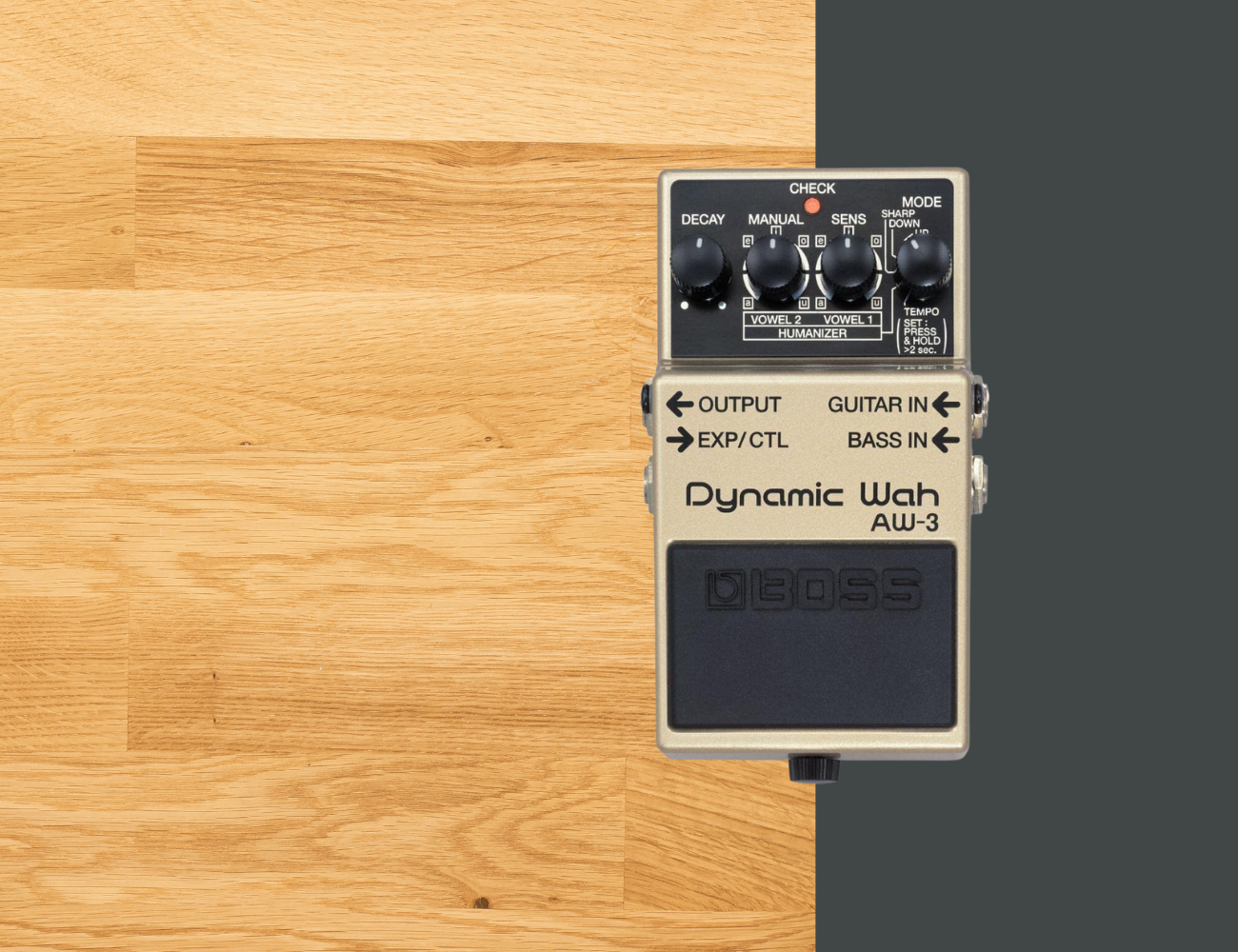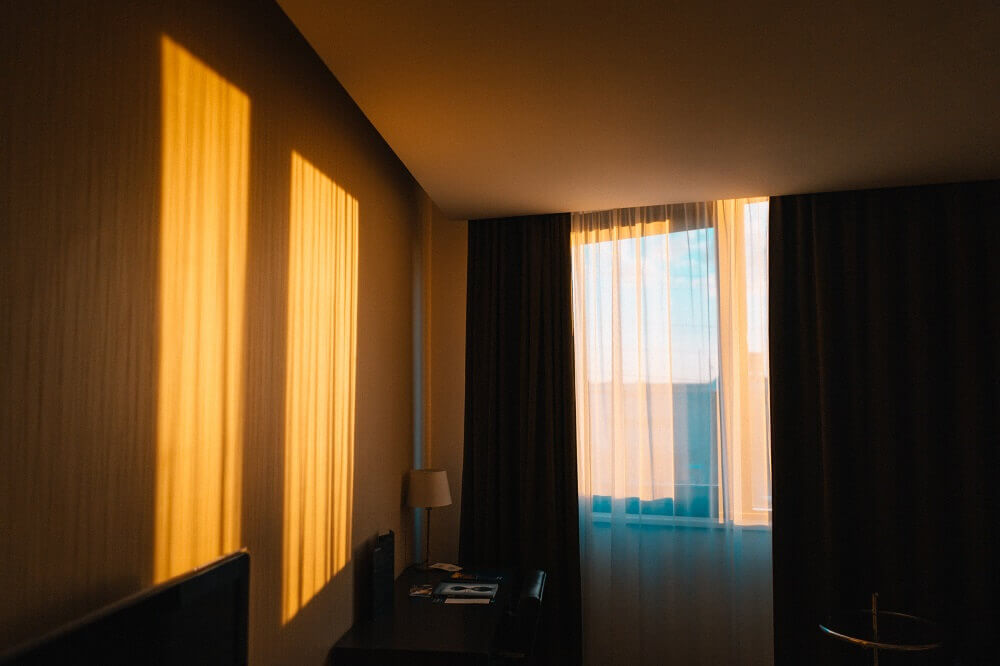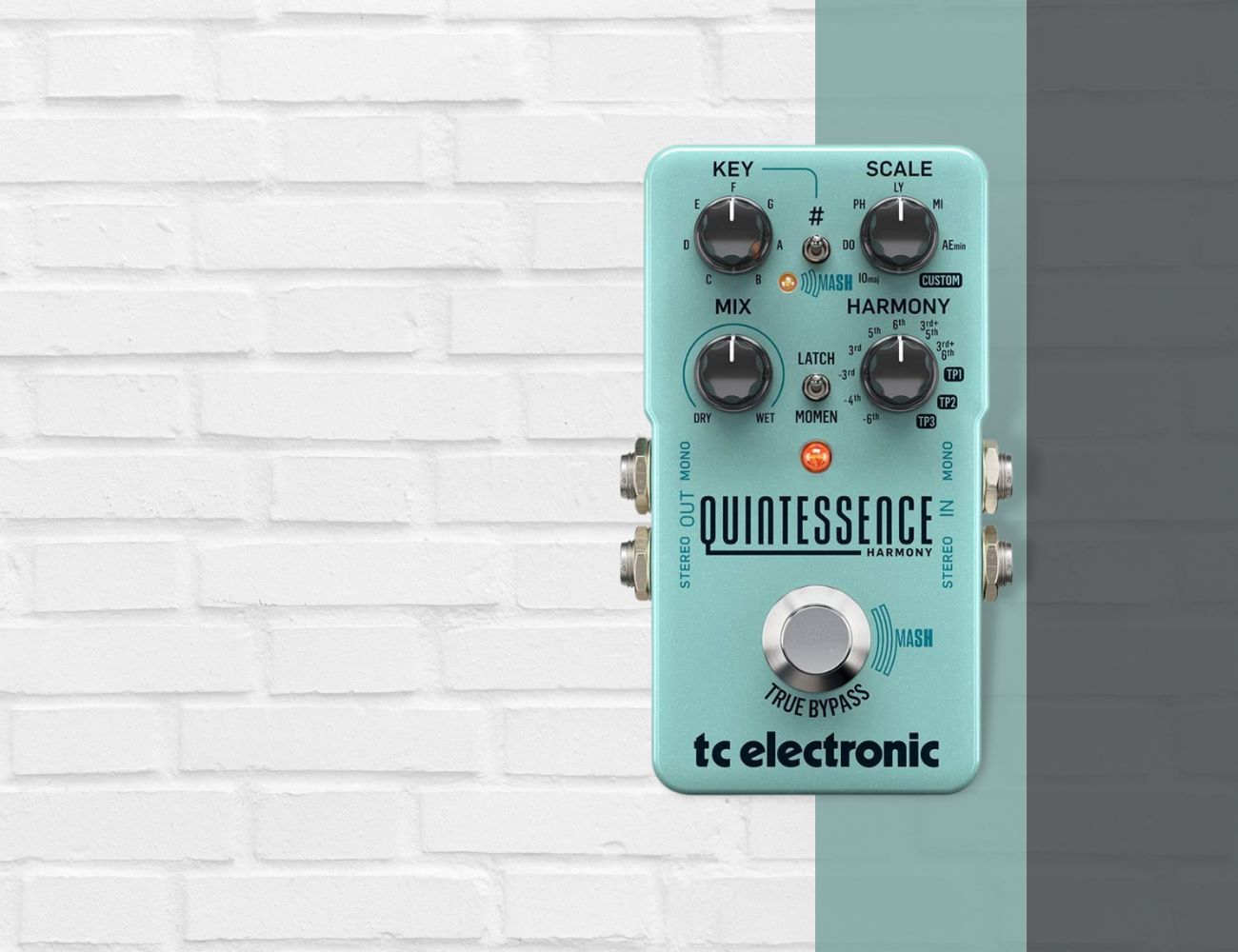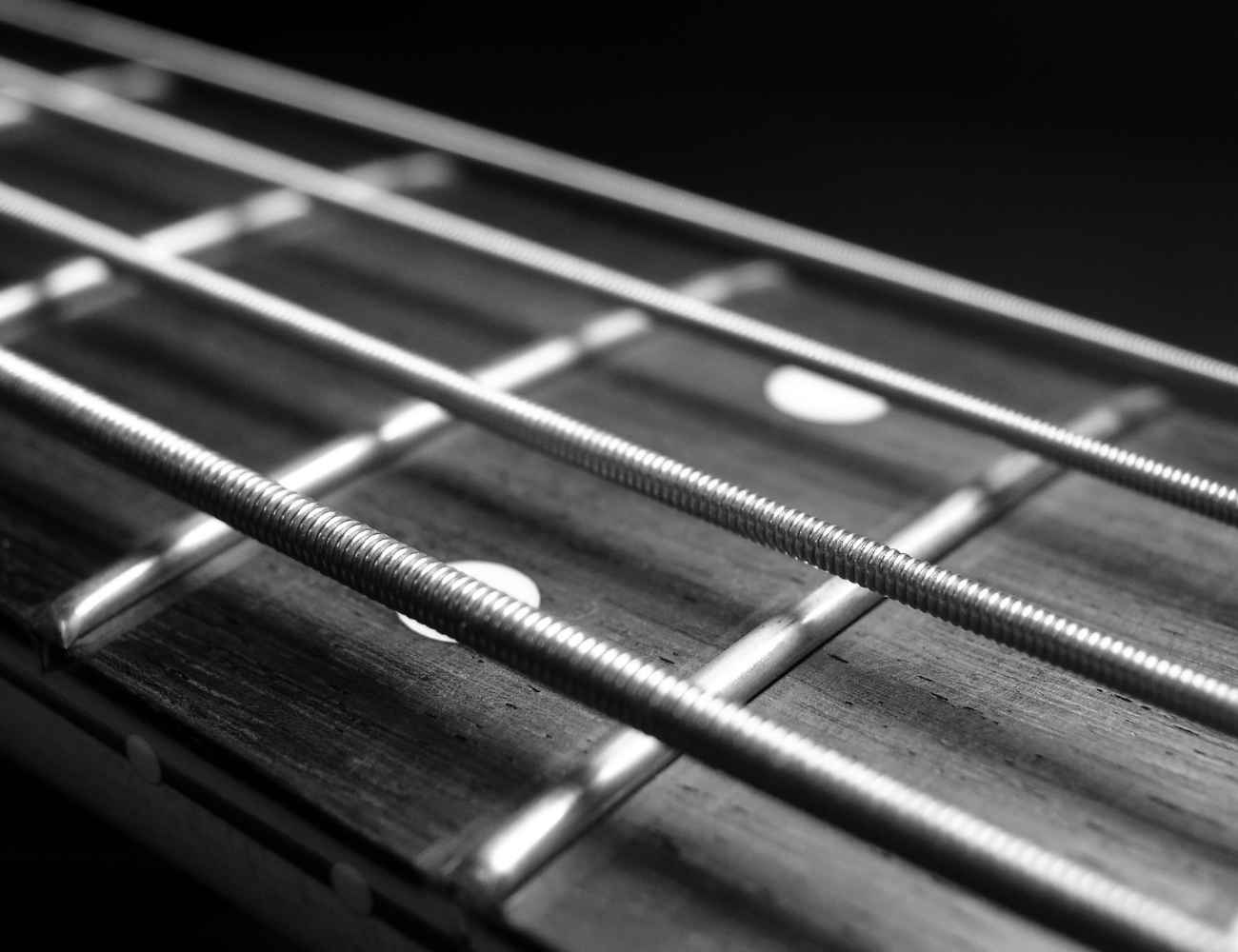Ever been blown away by the funky, groove-laden sounds of your favorite bands and wondered what secret weapon they’re using?
Chances are, it’s an envelope filter pedal!
We know you’re itching to learn more about the best envelope filter pedals today.
Get ready to get your groove on as we dive deep into the world of these expressive and versatile effects pedals that can transform your guitar or bass playing.
We promise you that after reading this article, you’ll understand the magic behind these pedals and be well-equipped to choose one that suits your needs and preferences.
And who knows your next funky riff could become the talk of the town!
Table of Contents
- Best Envelope Filter Pedals
- Boss AW-3 Dynamic Wah Pedal
- Fender Pour Over Envelope Filter Pedal
- Keeley Neutrino V2 Classic Envelope Filter Pedal
- EarthQuaker Devices Spatial Delivery V2 Envelope Filter Pedal
- EBS BassIQ Blue Label Triple Envelope Filter Pedal
- MXR Bass Envelope Filter Effect Pedal
- MOOER Sweeper Dynamic Envelope Filter Pedal
- Source Audio Spectrum Intelligent Filter Pedal
- Aguilar Filter Twin V2 Dual Bass Envelope Filter Pedal
- Donner Mini Auto Wah Envelope Filter Pedal
- Digitech XSW Synth Wah Envelope Filter Guitar Pedal
- What exactly is an envelope filter pedal?
- What should you consider when choosing an envelope filter pedal?
- How to properly use an envelope filter pedal?
- – Familiarize yourself with the controls and features:
- – Adjust the parameters to suit your musical goals:
- – Incorporate the envelope filter pedal into your signal chain:
- – Experiment with different playing techniques:
- – Fine-tune the settings while playing:
- – Utilize different effect combinations:
- – Practice and refine your technique:
- How to order pedals on a pedalboard?
- Boutique vs. Mass-Produced pedals
- How much should you spend on a guitar pedal?
- Can you use a guitar pedal with a bass guitar?
- How to properly power your pedals?
Best Envelope Filter Pedals
Before I begin, here are my top selected choices:
Boss AW-3 Dynamic Wah Pedal

Humanizer, Manual/Auto/Pedal Wah for guitar/bass with tempo control. Check Price
|
|
Donner Mini Auto Wah Envelope Filter Pedal

Donner Mini Auto Wah Pedal for versatile envelope filter and easy controls. Check Price
|
Boss AW-3 Dynamic Wah Pedal
Humanizer, Manual/Auto/Pedal Wah for guitar/bass with tempo control.
The BOSS AW-3 Dynamic Wah pedal offers a range of classic auto-wah and dynamic wah effects for guitar, plus a new “Humanizer” mode to simulate human vowel sounds. It also has a dedicated Bass input for funky wah sounds on bass guitar.
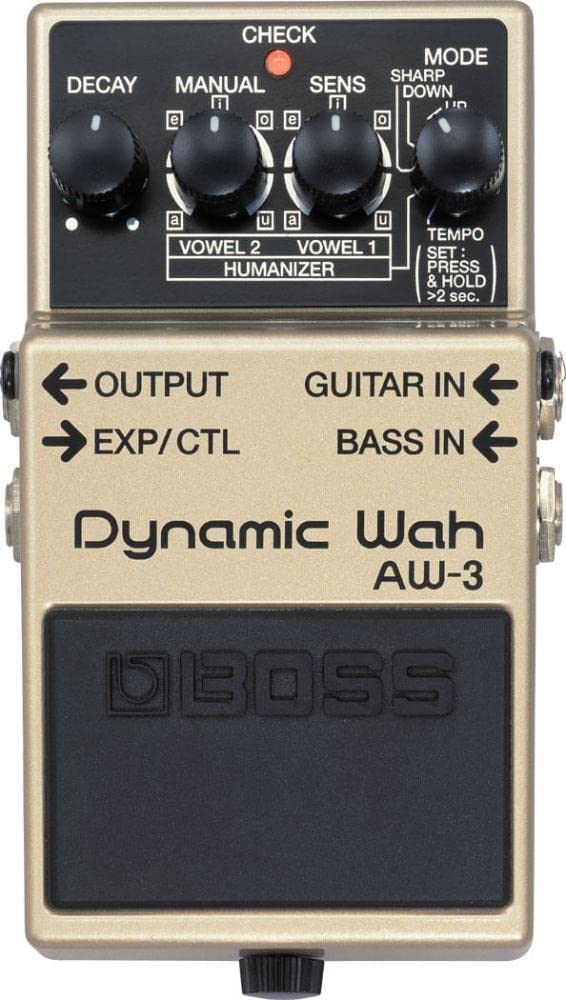
The Boss AW-3 Dynamic Wah Pedal is a versatile effects pedal for both guitarists and bassists.
This multi-colored, classic-style pedal measures 5.95 x 3.75 x 2.85 inches and weighs 1.3 pounds.
It features an envelope filter for guitar and bass with tempo control, an expression pedal input, and a unique “Humanizer” effect that simulates human vowel sounds.
As the first-ever compact wah pedal, the AW-3 stands out with its innovative “Humanizer” mode while providing standard up-and-down wah effects, tempo mode, and a resonant synth-like sharp mode.
You can choose from fixed and auto wah settings using manual control or the pedal for tempo input.
Connecting an optional expression pedal enables you also to use the AW-3 for pedal wah effects.
Additionally, the AW-3 has a dedicated bass input that allows the direct processing of bass guitars.
Crafted by the renowned brand BOSS, this high-quality wah pedal offers a wide range of sound possibilities to elevate your musical expression.
- My Review
As someone who enjoys a wide range of music styles and uses different effects pedals regularly, I tried out the Boss AW-3 Dynamic Wah Pedal.
This pedal brings a new level of versatility to wah effects, and I was quite impressed with its performance.
First off, I appreciate the compact design and durability of the pedal.
It easily fits on my pedalboard, and I trust the BOSS brand for its quality construction.
The AW-3’s multicolored finish adds a touch of flair to its appearance, making it a great addition to my setup.
The pedal allows me to explore a variety of sounds, from classic auto-wah and dynamic wah effects to the innovative “Humanizer” effect that creates human-like vowel sounds.
This fascinating and unique feature makes the AW-3 stand out among other wah pedals.
I played around with the AW-3’s manual control and pedal tempo input, which greatly controls my wah settings.
Here are the ratings I’ll give to the Boss AW-3 Dynamic Wah Pedal:
In addition, connecting an optional expression pedal provides even more flexibility by enabling me to use pedal wah effects.
Although the AW-3 is designed for guitar and bass with a dedicated bass input, I noticed that some bass tones could get lost when playing.
- Pros:
- Versatile wah effects.
- Compact and durable design.
- Innovative “Humanizer” feature.
- Cons:
- Some bass tones may get lost.
- Requires additional expression pedal.
- Learning curve for optimal settings.
My final verdict is that the Boss AW-3 Dynamic Wah Pedal is a solid choice for guitarists and bassists seeking versatile wah effects, unique features like the “Humanizer,” and the reliability of the BOSS brand.
Though there is a learning curve for achieving ideal settings and managing some lost bass tones, the overall performance and value make it a worthy investment for musicians looking to elevate their sound.
Fender Pour Over Envelope Filter Pedal
High-quality envelope filter with distortion, customizable filters, and stage-ready construction.
This Fender effects pedal features an all-analog design with selectable High-Pass, Low-Pass and Band-Pass filters, plus a built-in distortion circuit with dedicated controls. It has a dual-color LED and switchable LED-backlit knobs, making it ideal for dark stages.
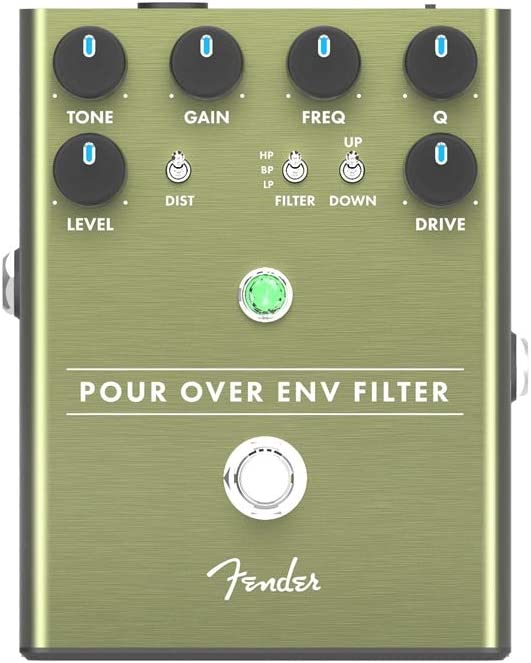
Taking inspiration from classic analog devices, the Fender Pour Over Envelope Filter Pedal is a remarkable blend of vintage charm and modern functionality.
It’s a robust tool built to withstand the rigors of the stage, yet it comes in a relatively compact form factor, measuring 5.4 by 4.9 by 2.9 inches and weighing just half a kilogram.
Its distinct olive-green and black exterior houses various features geared toward precision sound-shaping.
An in-built distortion circuit with dedicated controls for tone, level, and gain allows you to alter the character of your sound, and you can even bypass it if you wish.
You can also choose between Band-Pass, High-Pass, or Low-Pass filters, making it an excellent pick for guitar and bass players.
What sets the Pour Over apart is its dual-color LED, a feature that gives you immediate visual feedback when the filter is engaged.
Its compatibility with a standard center-negative 9VDC power supply makes it convenient, especially for those with existing pedalboards.
- My Review
Having spent considerable time with the Fender Pour Over Envelope Filter Pedal,I have much to say about this piece of gear.
Right off the bat, it’s hard not to notice the sturdiness of this pedal.
Fender has delivered a robust unit you can count on, even during the most energetic performances.
The size of the pedal, though, leaves a bit of a mixed impression.
On the one hand, it’s quite large compared to many modern micro pedals, which might concern those with already cramped pedalboards.
But on the bright side, this sizeable footprint gives ample space for controls, and believe me, there are plenty.
Indeed, what sets the Pour Over apart is its versatility.
Its onboard distortion circuit is a delightful addition, with a depth and range that surpass simple noise generation. This pedal’s controls over the tone, level, and gain are impressive.
Moreover, the filter selection is commendable, choosing between Band-Pass, High-Pass, and Low-Pass filters.
It’s this customization potential that makes it such a handy tool for both guitar and bass players.
However, I should note that dialing in precise filter settings can be somewhat challenging, which might be off-putting for some.
The dual-color LED deserves mention too.
It’s more than just a visual cue, it’s bright and noticeable, perhaps a tad too bright for some.
Despite this minor gripe, it’s a clever design choice that adds flair to the unit.
Regarding the pedal’s sound, it can be quite the chameleon. It offers a broad sonic palette, from producing funky auto-wah effects to extraterrestrial tone.
However, don’t expect it to replicate iconic sounds from specific musicians perfectly; it has a distinct character.
In terms of power supply, its standard center-negative 9VDC connection makes it easily compatible with most pedalboards, a small but essential detail that should not be overlooked.
The Pour Over pedal boasts excellent construction quality and stands out due to its distinct features that add to its allure.
Here are the ratings I’ll give to the Fender Pour Over Envelope Filter Pedal:
Its breadth of options might be a double-edged sword, potentially overwhelming for some yet thrilling for others.
I’d say give it a go, and you might be pleasantly surprised by what this pedal brings to the table.
- Pros:
- Wide range of usable sounds
- Sturdy and well-built
- Onboard distortion is versatile
- Cons:
- Difficult to dial in for some users
- Size is relatively large
- Bright LED light may be overpowering
My final verdict is that the Fender Pour Over Envelope Filter Pedal is a solid choice for musicians seeking a versatile and well-built pedal.
Thanks to its onboard distortion and selectable filters, it offers a wide range of usable sounds.
The pedal’s performance and brand reputation are generally positive, while its value is considered satisfactory.
However, some users may find it difficult to dial in, and the size could be a drawback for those looking for a more compact option.
Overall, the Fender Pour Over Envelope Filter Pedal earns a positive recommendation.
Keeley Neutrino V2 Classic Envelope Filter Pedal
Smooth, versatile auto-wah tone with opto-coupler technology.
The Keeley Neutrino V2 offers an opto-coupler based envelope filter for a vocal-like tone, with 3 filter ranges, 2 directions, 2 frequency center ranges, and a peak control. Its tough build and power supply voltage-doubler ensure maximum headroom and long-lasting performance.
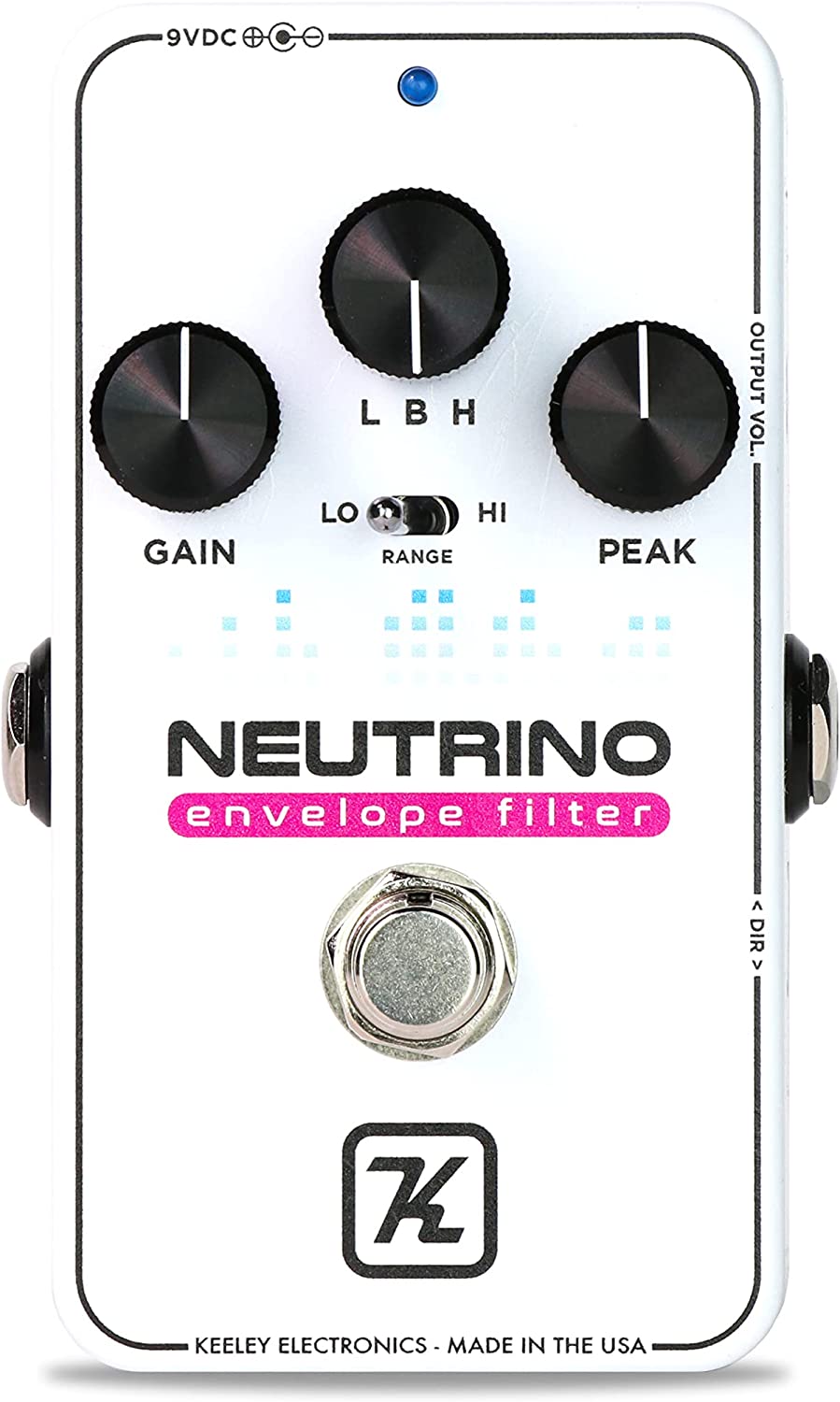
Presenting the Keeley Neutrino V2, a versatile envelope filter pedal designed for various instruments like guitars, basses, and keyboards.
This nifty device stands out with its “Peak Control” feature, which allows musicians to adjust their sound from an edgy “quack” to a smooth roll.
Its filter selector, another distinctive feature, offers three filter options: high, low, and band-pass, providing plenty of flexibility.
The range switch further complements these features, with the option of high or low settings.
This analog unit operates on a 9V DC supply, drawing a current of about 25 mA.
Manufactured in the USA, the Neutrino V2 is a product of true craftsmanship, featuring a robust build for long-lasting use.
One of its unique attributes is the opto-coupler-based envelope filter, creating an automatic wah sound that varies with your pick’s intensity, thus delivering a tone comparable to the human voice.
- My Review
Having spent ample time with the Keeley Neutrino V2, I’ve grown to understand its charms and quirks.
This envelope filter pedal is quite the unit, bursting with features that provide a broad spectrum of tonal possibilities.
Dialing between high, low, and band-pass filters, I discovered a multitude of soundscapes, each distinctive and robust.
The “Peak Control” offered its character element, enabling a shift from a subtle, smooth roll to a pronounced quack tailored to my playing style.
The innovative opto-coupler-based envelope filter was a real standout feature for me.
This function creates an automatic wah sound that instantly responds to pick attacks.
It yielded a range of tones, some so organic they resembled vocalizations – a fascinating and unique experience!
Nevertheless, despite its many positive aspects, the Keeley Neutrino V2 was not without its challenges.
One of the primary issues I faced was the sensitivity to pickup selection and playing intensity.
The pedal seemed to favor the bridge pickup, particularly humbuckers, and required a certain force in playing to achieve the desired ‘quack.’ This could limit its application for players favoring a softer touch or different pickup configurations.
Furthermore, dialing in a usable tone was a bit of a task.
Despite the various controls and settings, finding that sweet spot sometimes proved elusive.
It’s a device that undoubtedly requires patience and a keen ear for experimentation.
The Neutrino V2 is a testament to Keeley’s commitment to delivering unique, high-quality sound processing tools.
Here are the ratings I’ll give to the Keeley Neutrino V2 Classic Envelope Filter Pedal:
However, it may not be everyone’s cup of tea, given its sensitivity to playing dynamics and the sometimes tricky task of dialing in a preferred tone.
Remember, musical taste is subjective, so try it out and see if it suits your style.
- Pros:
- Fun and awesome when used traditionally.
- Compact and toneful design.
- Offers various filter options.
- Cons:
- No clear sweet spot for optimal tone.
- Limited pickup and playing requirements.
- Potential difficulty in getting support.
My final verdict is that the Keeley Neutrino V2 Classic Envelope Filter Pedal (KNeutV2) is a decent option for musicians seeking a compact and tuneful envelope filter pedal.
It offers a range of filter options and has received positive feedback for its traditional usage.
However, it may lack a clear sweet spot for optimal tone, has limitations in pickup selection and playing requirements, and there could be potential difficulties in obtaining support.
Considering these factors, it is recommended to carefully assess personal needs and preferences before purchasing.
EarthQuaker Devices Spatial Delivery V2 Envelope Filter Pedal
Voltage-controlled envelope filter for funk-filled tones.
The Spatial Delivery is an envelope filter that provides auto-wah and 3 modes of filter sweeps with range, resonance, and filter controls. It offers adjustable sensitivity and reaction time with the range and pick attack, creating a resonant lead tone when used with an overdrive/fuzz.
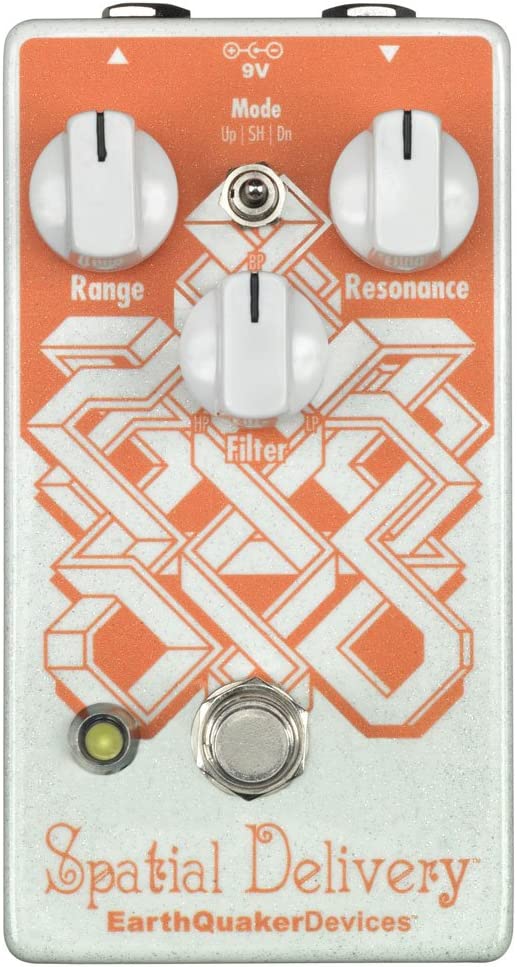
Let me tell you about the Spatial Delivery V2 Envelope Filter Pedal by EarthQuaker Devices.
Shaped with a quirky design, this pedal is far from your typical sound enhancer.
It flaunts three distinct modes—up sweep, down sweep, and a unique feature called ‘sample and hold‘. Each setting can produce a universe of sounds, from classic funk to unexplored sonic frontiers.
Crafted with range, resonance, and filter controls, this device offers a spectrum of filter sweeps in both upward and downward modes.
Depending on your choice of settings and the intensity of your pick attack, the pedal can vary in sensitivity and response time.
This flexibility defines the reaction’s speed and the frequency sweep’s scope.
Adding a touch of your preferred overdrive or fuzz after the Spatial Delivery can create a resonant lead tone that can easily cut through the mix.
Weighing in at just 0.75 pounds, the pedal has dimensions of 5.6 x 3.35 x 3.25 inches and operates at a voltage of 9 Volts.
The pedal indeed seems to promise an adventure in sound manipulation.
- My Review
As I explored the Spatial Delivery V2 Envelope Filter Pedal, I was impressed by its remarkable versatility.
This exceptional sound equipment offers three unique modes: up sweep, down sweep, and an interesting feature called ‘sample and hold’.
With these modes, I could create a wide range of sounds, from classic funk to futuristic, space-like tones, adding a new dimension to my music.
I deeply studied its features and found the range, resonance, and filter controls particularly noteworthy.
These controls let me finetune the pedal’s sensitivity and response time, broadening the scope of my sound experimentations.
Striking harder on the strings led to a quicker reaction and a wider frequency sweep, while softer strokes produced the opposite effect.
In essence, I was in full control of my musical expression.
Integrating my favorite overdrive or fuzz after this pedal offered me some real gems.
I discovered a rich, resonant lead tone that effortlessly sliced through the mix, adding much-needed depth and texture to my sound.
But it wasn’t all smooth sailing.
There were some minor inconveniences along the way.
The fact that a power supply was not included despite the premium price tag was somewhat disappointing.
I did expect that at a cost of nearly 200 pounds, all necessary peripherals would be a part of the package.
Another hiccup was a certain vulnerability in one of the modes after prolonged usage.
However, it’s important to remember that durability is often subjective and can vary with individual handling.
Despite these setbacks, I appreciated EarthQuaker Devices’ commitment to creating an innovative sound tool that breaks free from the norm.
Here are the ratings I’ll give to the EarthQuaker Devices Spatial Delivery V2 Envelope Filter Pedal:
With its funky capabilities and design, the Spatial Delivery V2 Envelope Filter Pedal may just be the missing piece in your sonic exploration.
It’s an investment, but it might just be worth considering.
- Pros:
- Wide range of filter responses
- Diverse and unique tones
- Sturdy build quality
- Responsive envelope and filter controls
- Cons:
- No power supply included
- Possible reliability issues with modes
- High price compared to features
My final verdict is that the EarthQuaker Devices Spatial Delivery V2 Envelope Filter Pedal offers a wide range of filter responses and unique tones, making it a versatile and performance-oriented option for guitarists.
The sturdy build quality and responsive envelope and filter controls contribute to its appeal.
However, the absence of a power supply and potential reliability issues with the modes could be drawbacks.
Additionally, the higher price compared to its features might not provide the best value for some users.
It’s recommended to carefully consider these factors and personal preferences before purchasing.
EBS BassIQ Blue Label Triple Envelope Filter Pedal
Fat analog filter effects for bass tone shaping.
The Darkglass Hyper Luminal Bass Effects Pedal offers bassists a wide range of analog filter effects, including a Subharmonic Generator, parametric EQ, and sweepable filter. It also includes a built-in noise gate and expression pedal input for real time sound control.
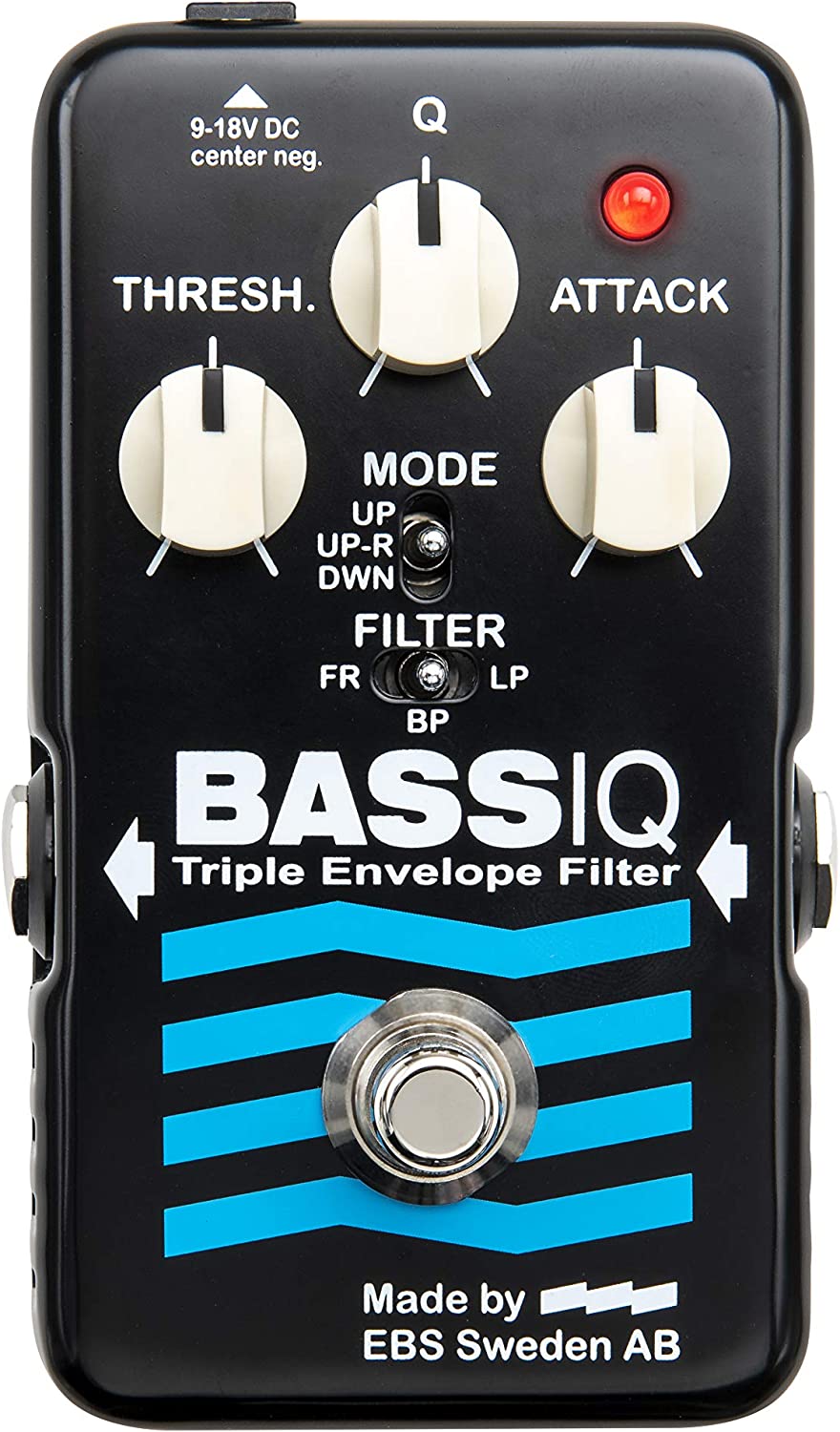
Dive into analog filter effects with the EBS BassIQ Blue Label Triple Envelope Filter Pedal.
This compact powerhouse, weighing only 315 grams, is easy to integrate into any setup, with dimensions of 6.3 x 4.33 x 4.33 inches.
Its versatility shines through with its low pass filter modes that provide a broad sound range, ensuring the perfect match for your style.
This pedal stands out because of its ‘Full Range’ feature that further enhances the sound quality by enabling a wider spectrum of audio frequencies to pass through.
This device runs on a 9-volt power supply and is built in a style that allows easy transportation and use.
Trust EBS, a well-renowned brand in the music industry, to deliver top-notch filter effects to transform your bass sound with the BassIQ Blue Label.
You’ll find it more than just a pedal – a ticket to a universe of sound possibilities.
- My Review
Laying my hands on the EBS BassIQ Blue Label Triple Envelope Filter Pedal, it was clear from the get-go that this was no ordinary equipment.
It’s feather-light, weighing just a touch above 300 grams, an impressive feat given its solid build.
Its compact dimensions made it a cinch to fit into my existing setup without needing a complete overhaul.
Plugging in and tuning up, I instantly noticed the range of the low-pass filter modes.
A discernible richness pervaded the tones, a testament to the versatility this little device holds within its frame.
From punchy lows to sparkling highs, nothing seemed out of reach for the BassIQ Blue Label.
The ‘Full Range’ feature is nothing short of a revelation, expanding the tonal palette to include even the most nuanced frequencies.
It’s akin to having a full-size analog filter at your disposal, yet housed within a sleek, portable package.
Running on a standard 9-volt power supply, there’s nothing fancy needed to power up this workhorse.
Regarding user-friendly design, EBS has knocked it out of the park.
The compact style does not compromise functionality, making navigating and adjusting settings easy.
While some pedals might be intimidating with their vast array of knobs and sliders, the BassIQ Blue Label keeps it refreshingly simple.
Suppose there was room for improvement, more information on fully exploiting the low-pass filter modes would go a long way.
The same goes for more guidance on dialing in the ‘Full Range’ feature for those new to envelope filters.
Here are the ratings I’ll give to the EBS BassIQ Blue Label Triple Envelope Filter Pedal:
However, in my book, these are minor quibbles in what is a standout product.
The EBS BassIQ Blue Label Triple Envelope Filter Pedal delivers a supreme sound experience, making it an essential addition to any serious bassist’s gear.
- Pros:
- Compact size
- Multiple envelope filter effects
- Full range and low pass filter modes
- Fat analog filter effects
- Cons:
- High price
- Limited customization options
- Potential learning curve for beginners
My final verdict is that the EBS BassIQ Blue Label Triple Envelope Filter Pedal is a highly versatile and feature-rich pedal that delivers excellent tone and performance.
Its compact size, multiple envelope filter effects, and full range and low pass filter modes offer a wide range of creative possibilities for bass players.
The fat analog filter effects add character and depth to your bass sound.
The EBS brand is well-known for producing quality musical equipment, and this pedal lives up to that reputation.
While it may come at a higher price point and have limited customization options, its overall value makes it a worthwhile investment for musicians seeking a reliable and professional-grade envelope filter pedal.
MXR Bass Envelope Filter Effect Pedal
MXR Bass Envelope Filter Effect Pedal: Professional quality effects for bass guitarists.
MXR is a renowned manufacturer of effects pedals, offering classic and modern designs since 1972. Its products are crafted with quality components and provide reliable performance for guitarists of all levels.
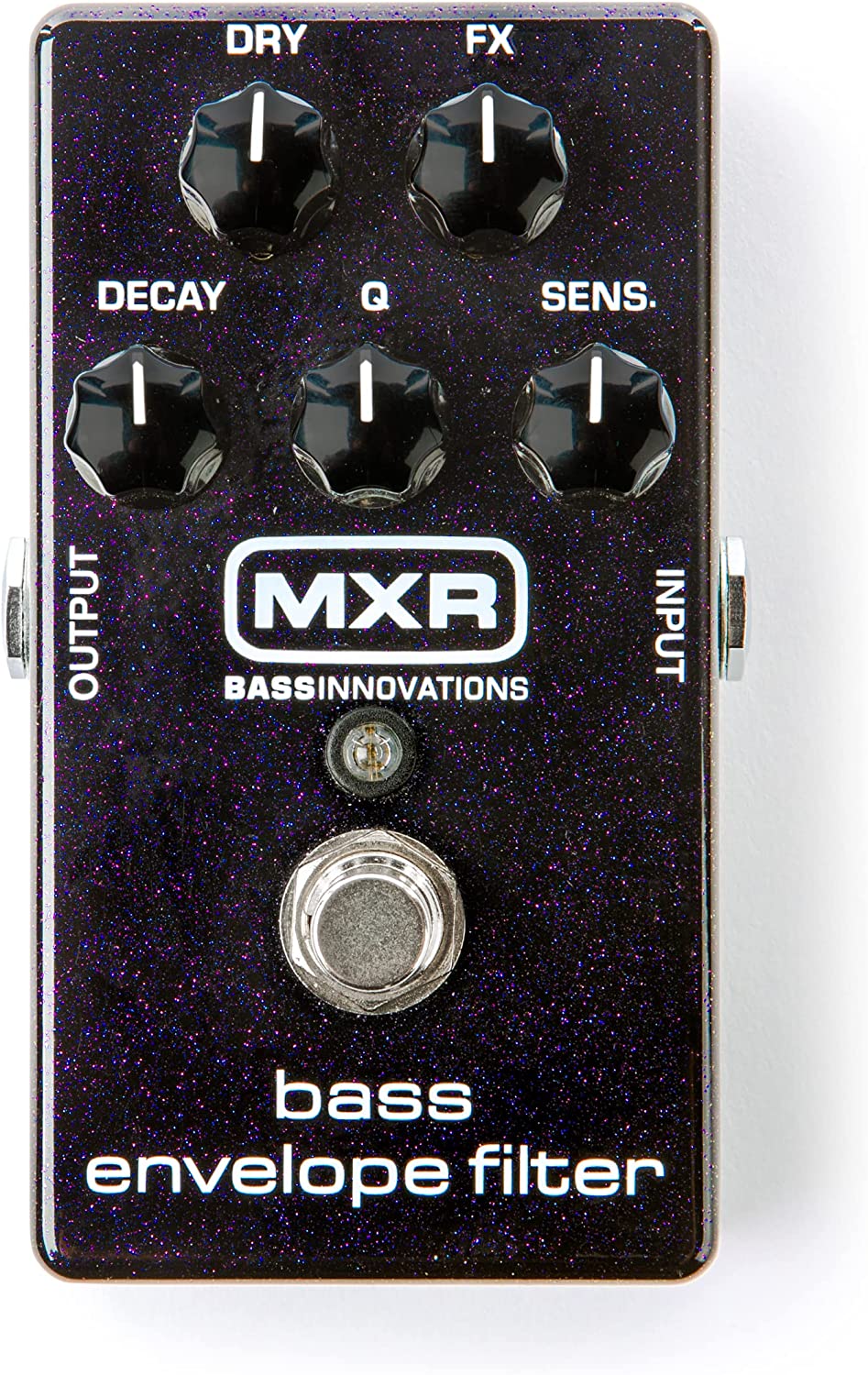
With the MXR Bass Envelope Filter Effect Pedal, you can harness the power of classic analog envelope filter sounds in a compact, user-friendly design.
Specially engineered for bass, this product gives you individual control over Dry and Effect signals, allowing for a perfect blend and ensuring you don’t compromise on the low end.
You can use the Decay and Q controls to fine-tune the filter tones.
Interestingly, the Sensitivity knob is adjustable for either passive or active basses.
Its robust power supply circuitry is built to safeguard against voltage spikes or polarity issues, while true-bypass switching makes sure your tone remains untouched in bypass mode.
Contained within a Phase 90-size aluminum shell, it’s designed for durability and space-saving.
This envelope filter effect pedal is a product from MXR, a New York-based manufacturer of effects pedals, now owned by Jim Dunlop.
- My Review
My journey with the MXR Bass Envelope Filter Effect Pedal has been quite the experience.
Immediately noticeable is the old-school charm of the analog envelope filter sounds it produces, carefully tailored for bass.
It’s compact and a breeze to use, which makes it a joy for musicians on the go.
What stood out to me were the separate Dry and Effect controls – the ability to tweak and find the perfect mix of affected and direct signals is a definite plus.
Unearthing an array of filter tones was a cinch with the Decay and Q controls.
I enjoyed this flexibility, though it took a bit of experimenting to hit the sweet spot.
One feature I found particularly thoughtful is the Sensitivity knob.
Whether you’ve got a passive or active bass, it covers you.
Despite these positives, the pedal has a few quirks.
One that stood out to me was the light.
It’s incredibly bright, almost distractingly so.
In the heat of a jam, the last thing you need is a pedal blinding you!
Additionally, while the compact design of the pedal is generally a boon, the small knobs can be a little fiddly and require a bit of patience to turn.
I must mention, too, that dialing the correct settings is a bit of an endeavor.
It’s not particularly beginner-friendly in that respect.
Built to withstand voltage mishaps, its power supply circuitry is hardy, and the true-bypass switching is a feature I appreciate.
Yet, I ran into a few power supply issues a few months into usage, which was somewhat annoying.
Here are the ratings I’ll give to the MXR Bass Envelope Filter Effect Pedal:
Encased in a lightweight, durable, Phase overall, I’d say it’s a solid pedal with a few quirks.
Its range of sound and functionality makes it a worthy addition to a bassist’s setup.
- Pros:
- Wide range of filter tones
- Separate controls for dry and effect signals
- Durable and lightweight aluminum housing
- Good for funk and rock genres
- Excellent tracking and versatile tones
- Cons:
- Some users experienced unpleasant peaks in the sound
- May require some time to find the desired tone
- Bright LED light can be distracting
- Not suitable for all music styles
My final verdict is that the MXR Bass Envelope Filter Effect Pedal is a highly capable and versatile pedal with various features that cater specifically to bass instruments.
It offers various filter tones, separate controls for dry and effect signals, and excellent tracking.
Its durable, lightweight construction and compact size make it convenient for transportation and pedalboard use.
While some users reported occasional issues with peaks in the sound and a bright LED light, this pedal delivers on its promise of delivering classic analog envelope filter sounds.
Considering its performance, brand reputation, and value for the price, I would recommend the MXR Bass Envelope Filter Effect Pedal to bass players seeking a versatile and reliable addition to their effects setup.
MOOER Sweeper Dynamic Envelope Filter Pedal
Unique, funky filter tones for bass and guitar.
This dynamic envelope filter pedal offers a unique, funky filter tone for bass and guitar. It has adjustable frequency and intensity controls to customize the sound to your preference.
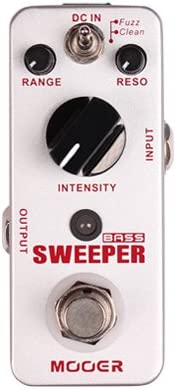
Introducing an effective, dynamic tool for your music gear, the MOOER Sweeper.
Not merely an envelope filter pedal, this device offers a unique, funky filter tone compatible with both bass and guitar.
With its two-mode switch, you can shift between clean and fuzz sweeping to enrich your sound further.
Its petite size and full metal body make it robust yet inconspicuous, saving valuable space on your pedalboard without compromising quality.
Operating on 9 volts, the MOOER Sweeper presents an analog signal format, thus ensuring a rich, natural sound output.
It fits into the ‘Bass’ and ‘Filter’ style categories and’s characterized by its distinctive Sweeper color.
Just imagine the creative possibilities with this little dynamo in your musical arsenal.
The MOOER Sweeper opens a new world of sonic exploration through its flexible features and compact design.
- My Review
I must admit that stepping into the realm of envelope filter pedals, the MOOER Sweeper caught my attention from the get-go.
It’s a deceptively compact piece of gear that packs an auditory punch, effortlessly blending in with my existing setup while promising an exploration of new sonic landscapes.
Firstly, let’s talk about the two-mode switch.
Flipping between clean and fuzz sweeping provides a breadth of tonal variations that are hard to find in similar products.
The clean mode delivered a smooth, silky tonal quality, while the fuzz mode added just the right amount of grit to make my tunes pop—a particularly satisfying feature for those craving a bit of funk in their music.
Next, the build. It’s robust and solid – a testament to the care MOOER puts into its products.
Although small, the full metal body can stand up to even the most enthusiastic jam sessions.
A true ally, unyielding in the face of stage antics or studio marathons.
What I found truly impressive was the analog signal format.
In the digital age, analog has a charm, a warmth that can sometimes be lost in translation.
The MOOER Sweeper captures this essence beautifully, producing a lush, full-bodied sound that’s as real as it gets.
And yet, there’s one aspect that I felt needed some tweaking – the color.
The distinctive Sweeper color is interesting, but I would love additional options for diverse aesthetic preferences.
A small gripe, I admit, but customization is key in the modern musician’s world.
Here are the ratings I’ll give to the MOOER Sweeper Dynamic Envelope Filter Pedal:
In my journey with the MOOER Sweeper, I discovered a versatile, reliable piece of equipment.
Yes, it has its quirks, but it also offers a unique musical experience that’s a delight to explore.
- Pros:
- Small and exquisite design.
- Unique funky style filter tone.
- Works well for both bass and guitar.
- Good quality build.
- Positive reviews on sound and performance.
- Cons:
- Not suitable for desired bass results.
- Potential issues with product condition.
- Some negative reviews on sound quality.
My final verdict is that the MOOER Sweeper Dynamic Envelope Filter Pedal is a solid choice for musicians looking for a compact and versatile filter pedal.
Its unique funky style filter tone offers good performance for both bass and guitar.
The positive reviews highlight its small, exquisite design and good build quality.
However, a few critical reviews mention potential issues with product condition and desired bass results.
Considering its features, tone, performance, brand reputation, and value, it is recommended for those seeking a dynamic envelope filter pedal.
Source Audio Spectrum Intelligent Filter Pedal
Premium, versatile FX for guitar/bass, all in one pedal.
This FX pedal provides a range of filter effects, octave sounds, and distortion for guitar and bass, with 3 distortion modes, true bypass, and a built-in noise gate for noise-free performance. Easy-to-use interface with knobs for level, tone, and drive make it suitable for many styles of music.
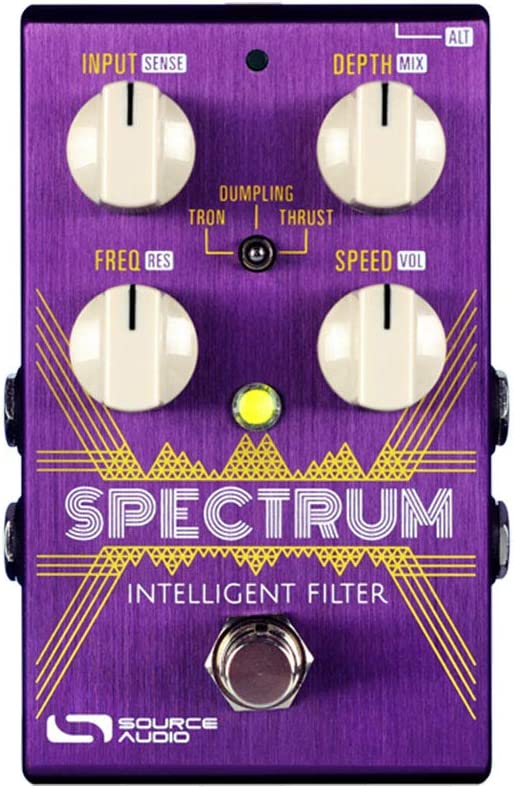
Offering an innovative and richly featured musical experience, the Source Audio Spectrum Intelligent Filter Pedal is a compact, lightweight, and multifaceted guitar/bass pedal designed for serious musicians.
It provides versatile sound effects, including filter, octave, and distortion, adding a unique layer to your music.
Not just limited to guitars, this pedal also caters to bass enthusiasts.
Weighing only a pound and measuring 10 x 7 x 6 inches, it’s compact enough to fit any gear bag.
It operates on a 9-volt power supply, making it simple and convenient to use in different settings.
The build of this device reflects its blend of elegance and functionality, making it a fitting addition to your musical gear.
What truly makes this Source Audio device special, however, is the customization options it offers.
It’s designed to allow you the freedom to produce any filter sound you wish, giving your music a truly personal touch.
- My Review
Let’s dive right into the Source Audio Spectrum Intelligent Filter Pedal.
Upon getting my hands on it, I was first taken aback by its compact yet robust design – ideal for those who value space without sacrificing functionality.
Weighing just a pound, it’s easy to carry around and set up anywhere.
I explored a world of varied and rich sound effects using the pedal.
From its wide range of filter sounds to distortion and octave effects, there seemed to be no end to its capabilities.
This pedal caters to musicians looking to experiment and find their unique sound.
However, there was a slight snag during initial testing.
It took a bit of fiddling to get the optimal sound settings.
While the default presets didn’t quite hit the mark for me initially, it was through the Neuro editor that this pedal showed its true colors.
One could argue that a pedal of this caliber should impress straight out of the box, but there’s also value in customization.
Once connected to the Neuro mobile app, the freedom to adjust and create my ideal sound was exhilarating.
From simple sound tweaks to complex alterations, the app provides an experience, crafting many unique sounds to explore.
And with the ease of connecting to the app, I could conveniently perfect my sound anytime, anywhere.
However, a slight concern arose regarding the pedal’s reliability.
During a few instances, it lost my presets mid-session.
It was a bit of a hassle, but it bounced back into operation after tinkering around a bit.
Despite these minor setbacks, my overall experience with the Source Audio Spectrum Intelligent Filter Pedal was positive.
Here are the ratings I’ll give to the Source Audio Spectrum Intelligent Filter Pedal:
A touch more reliability would be a truly unstoppable force in musical effects.
I look forward to watching the company improve on this already promising platform.
- Pros:
- Endless flavors of funk.
- Wide range of filter sounds.
- Compact and portable design.
- Easy connectivity with the Neuro mobile app.
- Positive customer service experience.
- Cons:
- Potential quality issues (smoking, switch failure, preset loss).
- Tron setting may not satisfy mutron enthusiasts.
- Controls may feel constraining and limited.
- Sound quality may be lackluster.
My final verdict is that the Source Audio Spectrum Intelligent Filter Pedal offers a wide range of versatile features and delivers a satisfactory tone for guitar and bass players.
The brand has a positive reputation, and the value provided by the pedal is commendable.
However, there are some reported quality issues and limitations in sound quality and controls that should be taken into consideration.
It is a solid choice for those seeking a compact and feature-rich filter pedal, but potential buyers should know the drawbacks mentioned.
Aguilar Filter Twin V2 Dual Bass Envelope Filter Pedal
Dual filters for organic, expressive tones.
The Filter Twin provides classic 70’s funk or unique new sounds with two adjustable filters sweeping in opposite directions. Offering a four-knob layout with blend, threshold, and velocity, it lets you adjust the mix and sensitivity of the filters with ease. *Power supply sold separately.
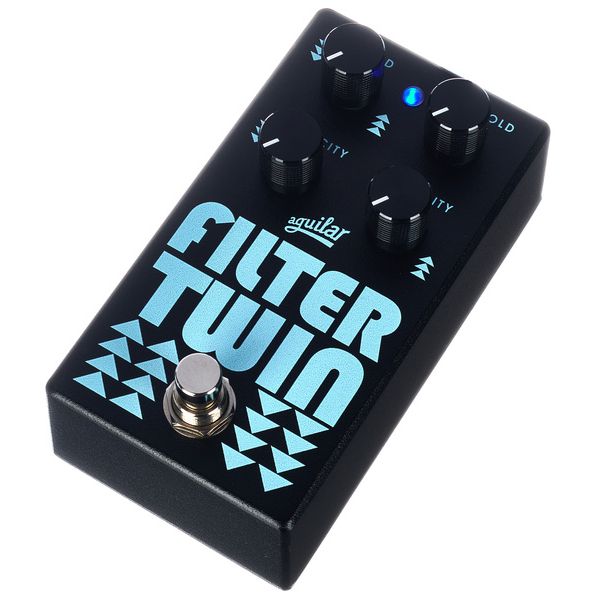
Crafted by Aguilar, the Filter Twin V2 is a compact bass envelope filter pedal that brings an innovative edge to the music scene.
It’s a lightweight device, tipping the scales at just 0.73 pounds, and fits comfortably in a space measuring 5.7 x 3.4 x 3.4 inches.
Its dual-filter design imbues uniqueness, featuring two filters that sweep reverse directions – one ascends in frequency while the other descends.
This approach harkens back to the distinctive funk tones of the 70s while paving the way for fresh, individualistic filter tones.
A more vocal, organic quality is achieved, lending your music a voice that traditional pedals may not reach.
You can tailor your sound with four intuitive knobs: BLEND, for adjusting the mix of filters; THRESHOLD, for setting sensitivity to different playing styles; and VELOCITY controls, for tuning the speed of each filter.
It should be noted, however, that a universal 9-volt power supply, not included in the package, is necessary to operate this pedal.
- My Review
Immerse yourself in the enchanting realm of music with the Aguilar Filter Twin V2.
This impressive gadget may seem small, but it is jam-packed with revolutionary features that make it remarkable.
Offering a rich and captivating auditory experience, the Filter Twin V2 surpasses expectations and delivers an unforgettable sonic journey that defies its size and weight.
Remarkably, I found its dual-filter system to be a real game-changer.
Imagine a dance, with one filter soaring high while the other plunges, creating a refreshingly different auditory weave.
For anyone craving that timeless funk vibe from the 70s, this pedal brings it back, infusing it with an original twist that opens up a whole new world of filter tones.
There’s also a unique four-knob layout, which was a highlight for me.
Each knob carries a distinct responsibility that empowers you to mold your music to your liking.
BLEND, for example, is an intuitive knob that lets you harmonize the two filters just right.
THRESHOLD allows you to set the device’s sensitivity, making it responsive to various playing styles.
But the real stars are the twin VELOCITY controls that tune the speed of each filter, adding a layer of expressiveness not often found in other pedals.
One thing that left room for improvement, however, was the power supply.
A universal 9-volt power source is essential, and it’s disappointing that one isn’t included in the package.
Here are the ratings I’ll give to the Aguilar Filter Twin V2 Dual Bass Envelope Filter Pedal:
But once you sort that out, you’re in for an experience that might change how you look at bass envelope filter pedals.
So, while it might not be perfect, it’s a pedal that pushes boundaries and doesn’t shy away from innovating.
- Pros:
- Compact size for easy portability.
- Offers versatile filter effects.
- Two filters sweeping in opposite directions.
- Allows for expressive and unique tones.
- Cons:
- May require a separate power supply.
- Potential learning curve for adjusting controls.
- Limited availability or higher price range.
My final verdict is that the Aguilar Filter Twin V2 Dual Bass Envelope Filter Pedal is a highly versatile and feature-rich pedal that delivers excellent tone and performance.
Its compact size and two filters sweeping opposite directions offer a unique and expressive sound experience.
The Aguilar brand is well-regarded in the industry, adding to the pedal’s credibility.
While the need for a separate power supply and a potential learning curve for the controls could be considered minor drawbacks, overall, the pedal provides excellent value for its features and capabilities.
Whether you want to achieve classic funk sounds or explore new filter tones, the Aguilar Filter Twin V2 is a solid choice for bass guitarists seeking creative and dynamic effects.
Donner Mini Auto Wah Envelope Filter Pedal
Donner Mini Auto Wah Pedal for versatile envelope filter and easy controls.
The Donner Auto Wah Pedal offers ease of control, wide flexibility, and a versatile envelope filter for a unique sound. Its efficient chip design ensures minimal noise and low power consumption, making it an ideal choice for guitarists seeking a dynamic effect. This pedal is part of Donner’s Vivid Series, an extensive line of high-quality guitar effect pedals, and is perfect for inspiring your sound.
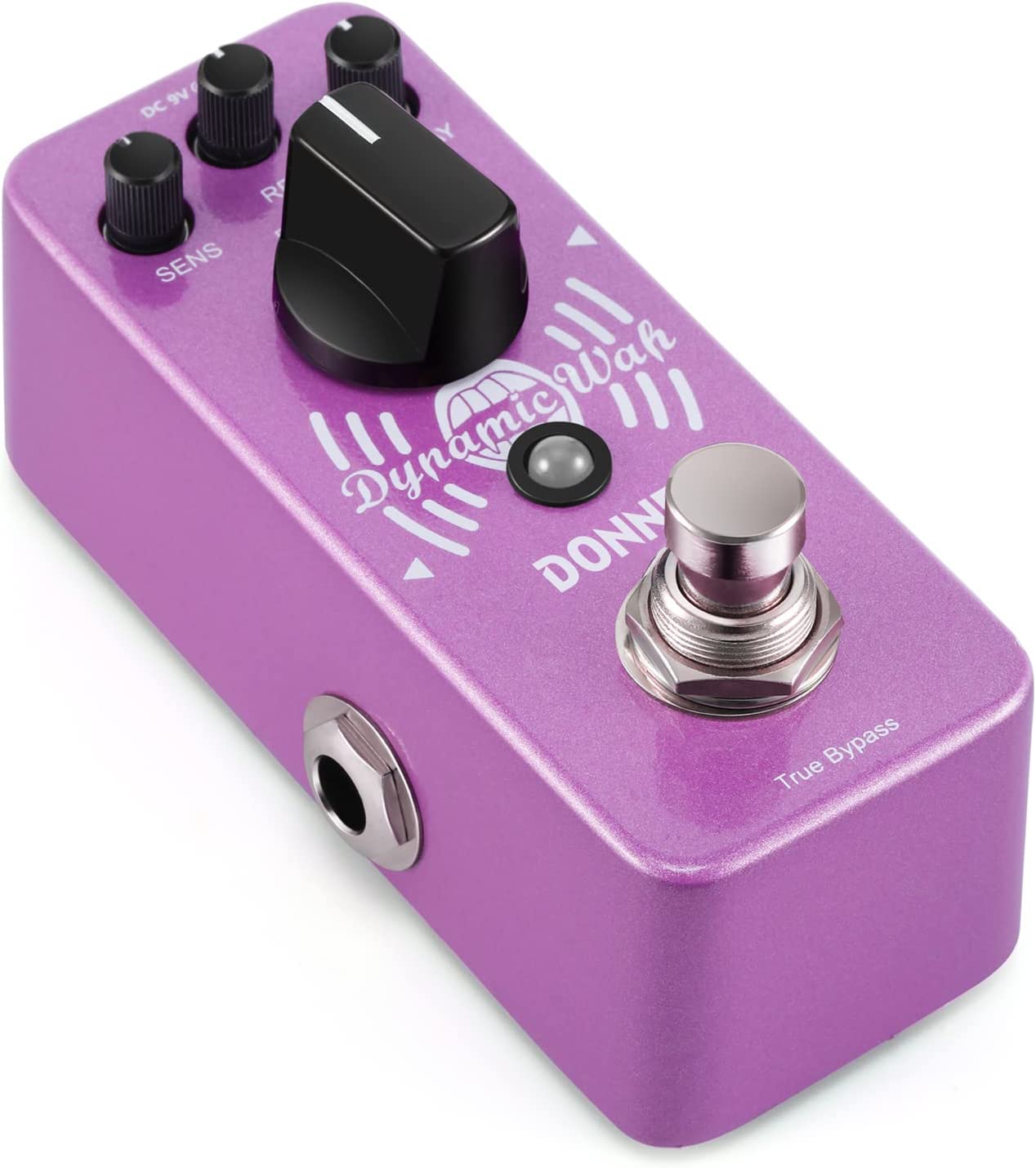
Dive into dynamic wah effects with the Donner Mini Auto Wah Pedal – a pocket-sized powerhouse designed for the serious guitarist.
This pedal offers a completely adjustable envelope filter with a distinct decay control feature for precise tracking.
You get four knobs that serve specific purposes.
The SENS knob adjusts sensitivity, RES refines the filter sharpness, DECAY determines how quickly the filter frequency retreats to rest, and RANGE customizes the filter frequency span.
An integral LED indicator communicates the operational status of the device.
Its true bypass feature ensures a transparent, uninterrupted tone thanks to the analog circuitry design.
Sporting an aluminum-alloy chassis, this compact pedal is robust and designed to withstand frequent use.
Remember, though, it operates on a 9V DC adapter which you’ll have to procure separately.
This pedal is a fusion of function, form, and convenience to amplify your sound experience.
- My Review
Ah, the Donner Mini Auto Wah Pedal.
Small but mighty, it truly packs a punch in the wah department.
Turning the knobs and adjusting the settings, you quickly discover the depth and range this mini marvel offers.
At the heart of it is a fully customizable envelope filter.
Decaying notes? No problem. The unique decay control assists, ensuring a speedy response and accurate tracking.
Playing around with the four-function knobs is akin to exploring a sound palette.
Adjusting the SENS knob, sensitivity modifications become a breeze.
The RES knob helps to tweak the filter sharpness to precision, while the RANGE knob works wonders to control the filter frequency span.
Each knob serves a clear purpose, lending complexity and variation to the sound produced.
Now, let’s talk about the LED indicator, a feature that impresses with its bright visibility.
The true bypass design, built with analog circuitry, is another highlight, providing a clear, uncolored tone.
This is is encased within an aluminum-alloy structure that gives the pedal an unexpected heft and durability.
However, let’s be real. It isn’t without its minor hiccups.
Powering up requires a 9V DC adapter, which isn’t included.
So, it’s an additional investment. Also, getting that perfect sound dialed in can be a bit finicky.
The knobs may seem small for those with larger hands, and precision might take some time.
Yet, once that sweet spot is found, it’s worth the effort.
Undeniably, the Donner Mini Auto Wah Pedal is a robust and affordable gear addition that deserves consideration.
It’s not flawless, but its quirks add to its character.
Here are the ratings I’ll give to the Donner Mini Auto Wah Envelope Filter Pedal:
It’s like having a mini sound engineer right on your pedalboard.
High-quality and affordable, this pedal is ready to shake up your sound experience.
- Pros:
- Accurate and fast tracking
- Compact and durable design
- LED indicator for working state
- Analog circuit design for transparent tone
- Cons:
- DC 9V Adapter power supply not included
- Some users experienced slight tone suck
- May require additional power supply adapter
My final verdict is that the Donner Mini Auto Wah Pedal is a versatile and feature-packed guitar effect pedal that offers excellent tone and performance.
Donner’s brand has consistently provided high-quality and affordable musical instruments and accessories.
Considering its competitive price, this pedal offers great value for money.
Whether you’re a beginner or an experienced guitarist, the Donner Mini Auto Wah Pedal is worth considering for its dynamic wah effects and reliable performance.
Digitech XSW Synth Wah Envelope Filter Guitar Pedal
7 unique synth effects, adjustable filter/frequency cutoffs.
The Synth Wah envelope filter offers 7 unique synth effects and adjustable controls for customizing your sound. Outputs include Normal (Dry) and Effect for an expansive range of sound-sculpting possibilities.
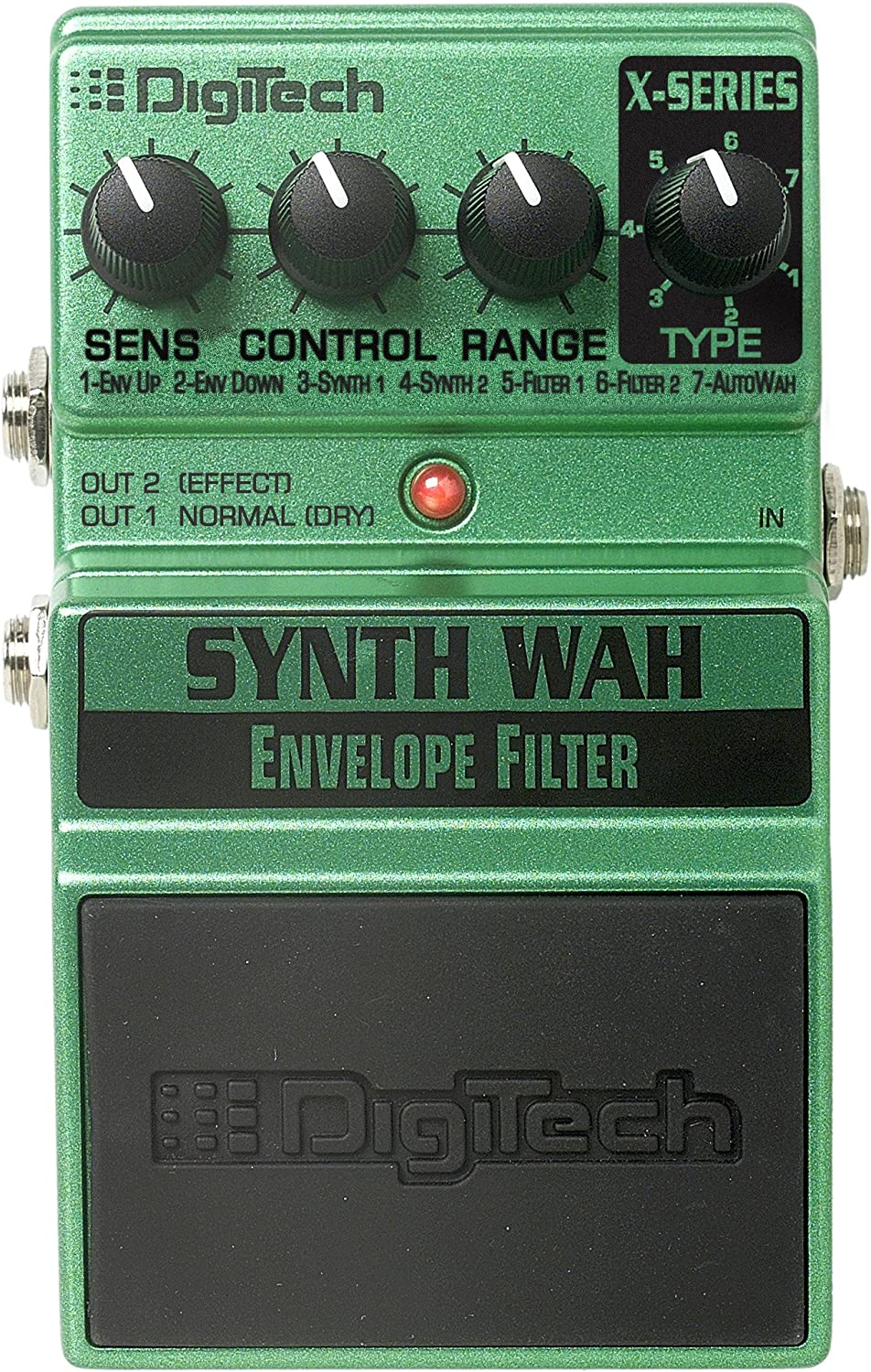
Looking at the Digitech XSW Synth Wah Envelope Filter Guitar Pedal, it’s evident that it has more to offer than your average guitar pedal.
One of its key highlights is the seven unique synths and envelope filter sounds it provides, a feature that lets you explore a spectrum of musical expressions.
Its versatility doesn’t stop there; it allows for customization with adjustable filters and frequency cutoffs.
It’s designed with two outputs – a Normal/Dry output for your guitar’s raw sound and an Effect output for the processed signal.
Notably, the Synth Wah Envelope Filter is a member of DigiTech’s acclaimed X-Series®.
What sets this pedal apart is the range of synth effects it hosts, encompassing envelope filters, synth tones, and filter sweep effects, providing a toolbox for creative exploration.
Easy to use, the controls include Sensitivity, Control, Range, and Type settings.
The range of outputs adds another layer of flexibility, catering to different sound needs.
- My Review
As I ventured into the world of the Digitech XSW Synth Wah Envelope Filter Guitar Pedal, I was pleasantly surprised by its impressive range of options.
The pedal immediately caught my attention with its seven unique synth and envelope filter sounds, offering various musical possibilities.
With the adjustable filter and frequency cutoffs, customization became effortless, allowing me to create my unique soundscape.
This level of flexibility is rare in guitar pedals, making the Digitech XSW a valuable addition to any musician’s collection.
One aspect that struck me was the pedal’s two output options.
Normal/Dry let the unaltered guitar sound shine through, while Effect allowed me to experiment with the synth-infused signal.
These options offer a dualistic experience – an auditory adventure into raw guitar sound and synthesized wonder.
Now, diving deeper into the synth sounds, I discovered various effects.
From vibrant envelope filters to resonating synth tones and sweeping filter effects, this pedal did more than add flavor to my playing – it transformed it.
The controls, including Sensitivity, Control, Range, and Type, were easy to grasp and allowed me to tailor the pedal to my playing style.
However, this pedal is not without its quirks.
I noticed it drains the battery rapidly, necessitating a separate power source for extended playing sessions.
Additionally, it’s important to note that the volume difference when the pedal is enabled can be quite pronounced, which could prove troublesome in live settings.
Here are the ratings I’ll give to the Digitech XSW Synth Wah Envelope Filter Guitar Pedal:
Despite these minor issues, the Digitech XSW Synth Wah Envelope Filter Guitar Pedal won me with its wide variety of sounds and simple yet robust controls.
The freedom it affords with its unique sounds makes it a fun and valuable addition to any guitarist’s rig.
- Pros:
- Versatile sound options
- Reasonable price
- Fun to use
- Good autowah effect
- Easy to operate
- Cons:
- Possible volume drop issue
- Requires separate power source
- Some limitations on sound variations
- Potential sound quality issues in bypass mode
- May not work well with high pitches
My final verdict is that the Digitech XSW Synth Wah Envelope Filter Guitar Pedal is a versatile and feature-rich pedal that can create unique and creative sounds.
It offers a range of synth and envelope filter effects, adjustable cutoffs, and multiple outputs.
The positive reviews highlight its fun factor and reasonable price, making it a valuable addition to any guitarist’s rig.
However, there are potential drawbacks, such as the volume drop issue, the need for a separate power source, and potential limitations in sound variations.
For guitarists looking to expand their range with innovative and atypical sounds, the Digitech XSW Synth Wah Envelope Filter Guitar Pedal is a must-see.
What exactly is an envelope filter pedal?
An envelope filter pedal is musical equipment used primarily by guitarists and bassists to shape their instruments’ tonal and sonic characteristics.
This versatile and widely-used effects pedal falls under the category of modulation devices, which alter the audio signal’s amplitude, frequency, and other aspects.
The envelope filter pedal, also called an “auto-wah” or “funky Q,” is renowned for its distinctive and funky sound, often heard in various genres such as funk, jazz, reggae, blues, and electronic music.
The name envelope filter comes from its primary function of applying a filter effect on an audio signal, which is determined by the envelope – the attack, sustain, and decay – of the sound being played.
This creates a dynamic effect that varies depending on the player’s attack, making it a unique and responsive tool for shaping an instrument’s tone.

– Components and functioning of envelope filter pedals
An envelope filter pedal typically consists of the following components: input and output connectors, power supply, filter circuitry, envelope generator circuitry, control knobs, and often a footswitch.
Input and Output connectors: These components connect the instrument or other sound sources to the pedal and link the pedal to an amplifier, effects processor, or recording device.
Power supply: An envelope filter pedal requires electricity, generally supplied through a power adapter connected to a power outlet or a battery.
Filter circuitry: The core of an envelope filter pedal informs how the audio signal is affected.
A signal passed through the filter is altered based on various parameters such as frequency, resonance (or Q), slope, and mix.
These parameters define the filter’s shape and determine how the output signal will sound.
Envelope generator circuitry: The envelope generator observes the input audio signal’s amplitude progression and generates a control signal to modulate the filter.
This dynamic component enables the effect to respond to the player’s playing style and attack, enhancing its versatility and expressiveness.
Control knobs: Envelope filter pedals offer a set of control knobs or sliders that adjust various effect parameters, such as sensitivity, resonance, attack, decay, and filter range.
Twiddling these knobs allows one to fine-tune the pedal’s sound.
Footswitch: Many envelope filter pedals have a built-in footswitch that enables or bypasses the effect at will; others may have additional switches for multiple settings or modes.
– Operation and usage of envelope filter pedals
Players can utilize an envelope filter pedal to achieve different effects based on their preferred genre or playing style.
For instance, the funk music genre often produces a textured and rhythmic sound used by bassists to create that signature “wah-wah” or “quack” effect.
The pedal is also essential for those aspiring for a diverse tonal palette.
This is due to its wide range of applications, including guitar solos, chord voicings or accompaniments, and even drum synthesis.
Pairing it with other pedals, such as distortion or overdrive, can further allow the production of more complex and unique tones.
First, as mentioned above, an envelope filter pedal is connected to a sound source and output device.
It crucially focuses on various adjustable knobs, each corresponding to a specific component in the audio signal processing.
The sensitivity control knob adjusts the input signal required to trigger the effect.
It closely responds to the instrument’s volume or amount of attack and can be tailored to accommodate various playing styles and expressions.
The filter control range modifies the frequency range over which the envelope filter effect operates.
This primarily determines whether a brighter, higher-tone, darker, or lower-tone effect is produced.
The attack and decay knobs adjust the filter’s time to reach its highest and lowest peak once triggered, enabling users to increase or decrease the filtering effects associated with the core sound.
Lastly, the resonance or Q control knobs influence the intensity and sharpness of the filter effect.
As the resonance increases, the filter’s response peaks become more drastic, creating a particularly unique sound.
What should you consider when choosing an envelope filter pedal?
When choosing an envelope filter pedal for your instrument rig, several factors must be considered to ensure you select the best pedal that meets your needs and personal preferences.
Careful deliberation of these aspects will help you make a more informed decision and maximize your investment.
– Sound quality
A great emphasis on sound quality is imperative when selecting the right envelope filter pedal for your musical endeavors, and it directly impacts the efficacy of the pedal in delivering the desired effects.
As such, keeping a keen eye and ear on the following factors will help you make the most informed choice while selecting the ideal envelope filter pedal based on sound quality.
Filtering characteristics: Envelope filter pedals utilize a variety of filter types, including low-pass, high-pass, band-pass, and notch filters, among others.
These filters can vary drastically in their sonic response, and the way they interact with your instrument will determine the overall impact on sound quality.
Therefore, be attentive to a pedal’s specific filtering options, as these characteristics will be the foundation of your desired sound.
Attack and decay response: An envelope filter pedal’s attack and decay aspects control how quickly the filter engages and disengages from the audio signal as you play.
These elements significantly shape the overall sound quality based on your playing style and the dynamic alterations you want to achieve throughout your performance.
As you evaluate envelope filter pedals, consider their capabilities in reproducing smooth, fluid rises and falls corresponding to your attack and release needs.
Sensitivity and response to playing dynamics: An essential attribute of envelope filter pedals is their ability to respond to the dynamics of your playing, such as the intensity of your picks or plucks.
This responsiveness imbues your music with expression and nuance.
Be diligent in choosing a pedal with high sensitivity and can distinguish between subtle changes in your playing dynamics.
Doing this will ensure the device produces optimal sound quality tailored to your unique playing style.
Noise levels: An envelope filter pedal may introduce unwanted noise or artifacts when engaged like any other effects pedal.
When evaluating sound quality, listening for any unusual or excessive noise caused by the pedal’s internal circuitry during operation is crucial.
Opt for a pedal with a low-noise floor and minimal extraneous sounds to ensure impeccable sound quality in your final output.
Compatibility with other pedals and gear: To cater to your distinct sound requirements, you may need to integrate your envelope filter pedal with other effects pedals or audio equipment in your instrument rig.
To maintain sound quality, ensure seamless Compatibility with your existing setup.
Compatibility should account for both tonal consistency and the suitability of audio connections.
This consideration will help you avoid unpleasant surprises or disruptive tones that might detract from the overarching sound quality during a live performance or recording session.
Tonal coloration and richness: Envelope filter pedals have unique tonal characteristics that can significantly influence the richness of your instrument’s sound.
Some pedals provide bright, crisp tones, while others offer warm, organic textures.
When selecting a pedal based on sound quality, carefully discern its range of colors and consider if they will complement your artistic vision or chosen genre.
– Controls and features
The controls and features of an envelope filter pedal are critical considerations that directly affect its usability and capability to generate a wide array of tonal variations.
By thoroughly investigating the available controls and selecting a device with clear, detailed, and easy-to-use features, you will ensure the pedal meets your demands in practicality and performance.

Here are a few elements to consider when evaluating an envelope filter pedal’s controls and features.
Essential parameter controls: When selecting an envelope filter pedal, ensure its primary parameter controls are readily accessible and adjustable during a performance or recording session.
These parameters include attack, decay, sensitivity, filter range, and resonance.
Access to these controls is crucial in allowing you to tweak your sound in real-time without hindrances, thus promoting enhanced expressiveness and creative freedom.
Additional controls and modes: Apart from the essential controls, many envelope filter pedals have extra features that provide versatility.
This could include options for multiple filter types (low-pass, high-pass, band-pass, or notch), selectable filter slopes, modulation or sweep settings, and multi-mode filter selection switches.
Deliberate upon the need for this additional functionality when choosing a pedal and weigh its usefulness against the initial learning curve or complexity.
Control layout and ergonomics: The arrangement and visibility of controls on an envelope filter pedal are equally important in ensuring precise and efficient sound modulation.
A well-designed control layout facilitates ease of use, improved control, and excellent visual acuity to see settings on a dimly lit stage or in direct sunlight.
Contemplate the pedal’s ergonomics to guarantee both performance accuracy and convenience.
Footswitch quality and functionality: Envelope filter pedals usually incorporate one or more footswitches that activate and deactivate the effect or control other modes and settings.
Assess the quality and performance of the footswitch mechanism to ensure smooth and glitch-free operation.
Also, consider if additional footswitches or external control options are necessary based on your requirements and preferences.
Visual feedback indicators: Some envelope filter pedals include visual feedback indicators, such as LED lights, to show the pedal’s current settings or modulation rate.
These indicators can help you stay well-informed about the pedal’s performance parameters and assist in achieving accurate sound adjustments as needed.
Analyze the effectiveness of a pedal’s visual feedback display and ensure it offers sufficient clarity and usefulness during practice or gigs.
Pedal size and format: Envelope filter pedals come in various sizes and formats, including compact or full-sized pedals.
When evaluating the controls and features of a pedal, consider the pedal size as it pertains to your available pedalboard space, portability, and whether there are any compromises in usability due to a smaller form factor.
– Analog vs.Digital
One pressing debate amongst envelope filter pedal enthusiasts is whether to opt for the warm and organic tones of analog pedals or the versatility and precision of digital counterparts.
Analog envelope filter pedals often deliver a more rounded sound due to their incorporation of analog circuitry and components.
These pedals benefit from their inherently smooth tonal response and unique character closely associated with classic envelope filter effects.
Meanwhile, digital envelope filter pedals afford cutting-edge technology, enabling more advanced features and customizable options, like extended equalization possibilities, multi-filter types, and elaborate waveforms.
However, this enhanced flexibility may come at the expense of authentic tonal warmth, which purely analog devices effortlessly deliver.
Thus, deliberate your preferences and requirements as you decide whether an analog or digital pedal best suits your needs.
– Build quality and durability

Like any other musical equipment, envelope filter pedals must endure frequent wear and tear, especially when unpacked and repacked while gigging.
Consequently, prioritize the pedal’s build quality and durability to ensure that it can endure continuous use without fail.
Consider a pedal encased in robust and sturdy materials, like metal housing, secure connector jacks, and high-quality components.
A solid pedal build will offer confidence in performance and long-term reliability.
– Presets and versatility
Presets and versatility contribute significantly to the efficiency and flexibility of an envelope filter pedal, allowing musicians to access a wide range of sounds and textures with minimal effort.
To ensure you make the most of these features in the chosen pedal, consider the following factors.
Number of presets: When selecting an envelope filter pedal with presets, evaluate the number of available presets and consider whether this variety will suit your needs.
Numerous presets can save time during rehearsals or live performances, as they minimize the need for constant manual tweaking and allow you to access different sounds effortlessly.
Editability and customization: Many modern envelope filter pedals allow users to modify and create custom presets, an advantageous feature that enables personalized sound sculpting.
Assess the level of control and user-friendliness in editing and storing presets, as this understanding will ensure optimal performance and ease of use throughout the pedal’s life.
Multiple filter modes: Envelope filter pedals with multiple filter modes extend their versatility, granting access to various filtering options, such as a low-pass, high-pass, or band-pass filter.
Contemplate your desired tonal spectrum, and consider whether multiple filter modes benefit your settings and styles.
Integration with other effects: Versatility also comprises the Compatibility of an envelope filter pedal with other effects in your signal chain.
Check the suitability of incorporating your pedal with overdrive, distortion, or modulation effects for enhanced tonal possibilities without compromising sound quality or ease of use.
Genre adaptability: If you are a musician performing across multiple genres or constantly experimenting with new sounds, seek an envelope filter pedal with adaptability and versatility to accommodate diverse styles.
Bearing this criterion in mind during the selection process ensures your needs are met regardless of the musical context.
Compatibility with instruments: Many envelope filter pedals are designed for specific instruments, such as guitars or basses, but some cater to various instrument types for increased versatility.
If you play multiple instruments or plan to use the pedal in a multi-instrumental setup, be mindful of its Compatibility and presets catered to other instruments to maximize its usefulness.
– Brand reputation

A brand’s reputation speaks to its products’ quality, reliability, and performance.
Choosing a well-regarded and established brand when purchasing an envelope filter pedal increases the likelihood of receiving a robust, high-quality device that consistently delivers on its promise.
However, be cautious not to overlook newer or lesser-known manufacturers that may offer innovative designs or incredibly personalized customer support.
– Price and budget
Envelope filter pedals come in a wide range of prices, from budget-friendly options to premium, high-end devices.
As you search for a pedal, consider your budget and prioritize the most important features.
While it may be tempting to buy an affordable pedal, be wary of poorer build quality, low sound fidelity, or insufficient features.
Conversely, expensive pedals may boast several features that exceed your requirements or offer subtle improvements in sound quality that are not justifiable for your budget.
Striking a balance between performance, requisite features, and affordability is crucial when making your decision.
– Reviews and recommendations
Lastly, consulting reviews, recommendations, and advice from professionals, fellow musicians, and online forums are important.
Familiarize yourself with the experiences of others who have purchased and used the specific pedal models you are evaluating.
Take note of recurring concerns or issues and gather insights to help narrow your options or decrease potential uncertainties.
How to properly use an envelope filter pedal?
We will delve into properly using an envelope filter pedal to enhance your playing and achieve the desired effects.
Following these steps will ensure successful integration and usage of the envelope filter in your musical endeavors.
– Familiarize yourself with the controls and features:
Start by familiarizing yourself with your envelope filter pedal’s specific controls and features.
Most envelope filter pedals will have a set of knobs to tweak different parameters and dial in the desired effect.
Some common controls include:
Sensitivity (Input Level / Threshold): Controls how easily the incoming signal triggers the effect.
Turning this up will result in the effect being triggered more easily.
Filter (Depth / Intensity): Controls the degree of filtering, i.e., the effect’s intensity.
Attack: Determines how quickly the filter effect builds after it’s triggered.
Decay (Release / Sustain): Controls how long the effect lasts after it has been triggered.
Q (Resonance): Sets the sharpness or emphasis of the filtered peak, creating a more drastic and pronounced effect.
Some envelope filter pedals may include additional controls or features, such as selectable filter types, blend controls, or frequency range selectors.
– Adjust the parameters to suit your musical goals:
Experiment with the available parameters to properly use an envelope filter pedal to achieve the desired effect.
Adjustments to settings like sensitivity, filter depth, attack, and decay greatly affect the overall response and feel of the effect.
When tweaking your settings, consider your musical goals and what type of envelope filter effect you wish to achieve, subtle or dramatic.
Suppose you’re unsure about which settings to use.
In that case, you can consult the pedal’s manual or search for online resources providing suggestions and tips for popular envelope filter sounds and settings.
– Incorporate the envelope filter pedal into your signal chain:
Placement in your signal chain plays a key role in achieving optimal performance from your envelope filter pedal.
Typically, high-gain distortion or compression effects should be placed before the envelope filter to provide a consistent input signal and maintain the envelope filter’s dynamic response.
Similarly, modulation or time-based effects such as chorus, delay, or reverb usually come after the envelope filter to avoid muddying the overall sound.
Depending on your taste and specific effects setup, you may need to experiment with different signal chain placements until you find the one that best suits your needs.
– Experiment with different playing techniques:
The envelope filter is unique among effects pedals in that its response directly relates to your playing technique.
Experiment with various playing techniques, such as fingerpicking, slap and pop, using a pick, or tapping to create different envelope filter effects.
Additionally, the range of dynamics in your playing, from softer to harder picking or plucking, will significantly shape the effect.
Consequently, developing a consistent and controlled playing technique will allow you to utilize the envelope filter pedal’s full potential better.
– Fine-tune the settings while playing:
As you play through your chosen piece of music, adjust the sensitivity, frequency, and other parameters of the envelope filter pedal to suit the desired effect.
You are making these adjustments while playing enables you to fine-tune the settings based on the dynamics and nuances of your performance.
Note that sometimes slight adjustments can significantly impact the resulting filtered sound, so it is essential to listen carefully and make incremental changes as needed.
– Utilize different effect combinations:
Combining an envelope filter pedal with other effects such as distortion, delay, or reverb can create a unique sound worthy of exploration.
Experiment with various combinations, and do not be afraid to push the boundaries, as new and interesting tones may arise from unexpected pairings.
You can expand your sonic palette by incorporating different effect combinations, providing inspiration, and rekindling creative energy.
– Practice and refine your technique:
Properly using an envelope filter pedal requires ongoing practice and focus on refining your technique.
Becoming comfortable with the effect’s nuances and how it interacts with your instrument and other pedals in your rig will enable you to use the envelope filter pedal more effectively during performances and recording sessions.
Practicing with a metronome can improve your timing and precision, which will positively impact the dynamics of the envelope filter effect.
How to order pedals on a pedalboard?
There is no one-size-fits-all approach to ordering pedals on a pedalboard, as the optimal arrangement largely depends on the specific sound you’re aiming for.
Usually, though, you will see guitar players mostly agreeing with this order:
Tuner > Filters/Dynamics > Pitch-based Effects > Overdrive/Distortion > Modulation > Time-based Effects > Looper
Aside from that, some general guidelines can help you achieve a balanced and versatile setup.
Let’s talk in detail about the order we just mentioned, but feel free to experiment and adjust to your own preferences:
- Tuner: Place your tuner pedal first to ensure your signal is in tune before passing through the other pedals.
- Filters and dynamics: Wah-wah, envelope filters, compressors, EQs, and noise gates should come next. These pedals affect your sound’s dynamic and tonal aspects, so it’s best to place them early in the chain.
- Pitch-based effects: Octavers, harmonizers, and pitch shifters should come after filters and dynamics since these pedals alter the pitch of your signal and work best with a clean, unprocessed sound.
- Overdrive and distortion: Overdrive, distortion, and fuzz pedals typically come next. They shape your guitar’s core sound, and placing them before most other effects ensures that those effects receive a strong, consistent signal.
- Modulation effects: Chorus, flanger, phaser, and tremolo pedals should be placed after overdrive and distortion effects. We do this to allow these pedals to add depth and movement to your sound without becoming overly distorted or overbearing.
- Time-based effects: Delay and reverb pedals should be placed towards the end of your signal chain. This allows them to create a sense of space and depth around the other effects, simulating the sound of a room or hall.
- Looper: If you use a looper pedal, it should be placed last in the chain. This ensures that you’re looping the entire signal, including all the effects you’ve applied.
Remember, these are just general guidelines and what generally works and sounds good.
The most important thing is to experiment and find the arrangement that best suits your personal sound and style.
For example, here’s one pedalboard signal chain that I always use:
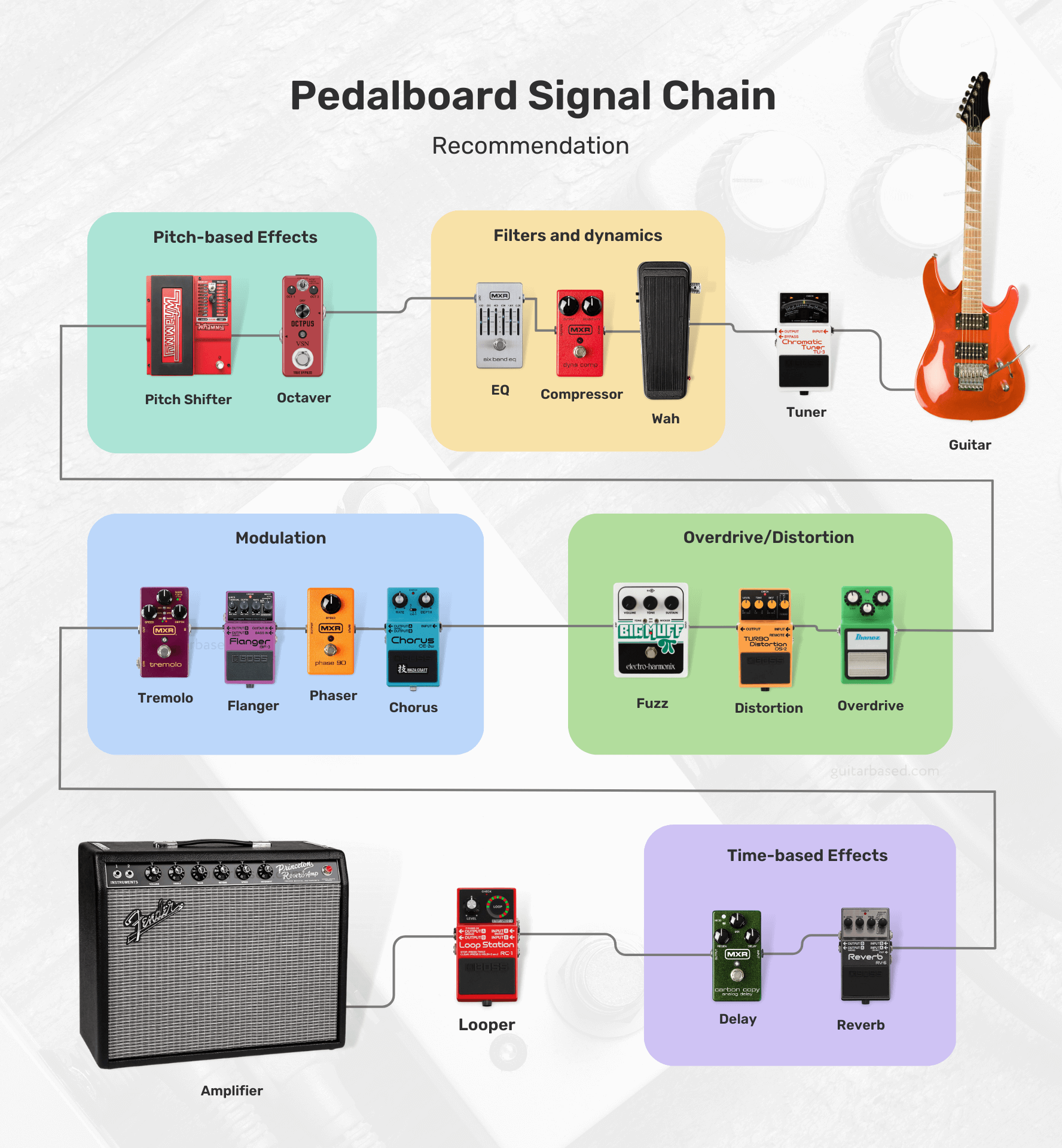
Feel free to swap the order of pedals, try different combinations, and test out unconventional setups until you find the one that works best for you.
For those interested, I’ll leave you with most of the possibilities that you’ll encounter and how to order them.
- Tuner
- Filters/Dynamics:
- Volume
- Wah
- Auto-Wah
- Compressor
- Noise Gate
- EQ (Equalizer)
- Pitch-based Effects:
- Octaver
- Harmonizer
- Pitch Shifter
- Overdrive/Distortion/Fuzz:
- Boost
- Overdrive
- Distortion
- Fuzz
- Modulation:
- Chorus
- Phaser
- Flanger
- Univibe
- Vibrato
- Tremolo
- Time-based Effects:
- Delay
- Echo
- Reverb
- Synth/Bitcrusher:
- Synth
- Bitcrusher
- Acoustic Simulator
- Multi-Effects
- Utility:
- Buffer
- A/B/Y Switcher
- MIDI Controllers
- Looper
Boutique vs. Mass-Produced pedals
Boutique pedals are generally built with higher-quality components and craftsmanship, resulting in better durability and longevity.
These pedals often feature unique and innovative designs, providing a wider range of tones and effects that may not be available in mass-produced options.
Here are a few examples of boutique pedals:

All the manufacturers also tend to have a more personal approach, with better customer service and the ability to customize pedals according to the user’s preferences.
However, boutique pedals are usually more expensive due to the smaller scale of production and the use of premium components.
Mass-produced pedals, on the other hand, are more affordable due to their larger scale of production and the use of cost-effective components.
These pedals are widely available and offer a range of popular effects, making them accessible to a larger audience.
Here are a few examples of mass-produced pedals:

The quality control for mass-produced pedals can vary depending on the brand and model, but many are reliable and offer good value for the money.
As for one of the downsides, you’ll find that mass-produced pedals may not have the same level of uniqueness or innovation as boutique options.
On the other hand, they may not provide the same level of customer service or customization options.
The choice between boutique and mass-produced pedals depends on your personal preferences, budget, and desired sound.
If you’re looking for unique tones, higher-quality components, and a more personal experience, boutique pedals may be the way to go.
But I would say, for those who are on a budget and need access to popular effects, mass-produced pedals might be a better fit.
It’s worth trying out both types to see which best suits your needs and playing style.
How much should you spend on a guitar pedal?
If I were in your position, I would first determine my budget and specific needs before deciding how much to spend on a guitar pedal.
For beginners, it might be more reasonable to start with affordable, mass-produced pedals to explore different effects without spending too much.
Guitar pedals can range in price from around $30 to over $400, depending on the brand, quality, and complexity of the effect.
As your skills and understanding of your preferred tone develop, you can gradually upgrade to higher-quality or boutique pedals.
One thing I would do is consider which effects are essential to your playing style and prioritize purchasing those first.
Allocating a larger portion of your budget to the most important pedals might be a wise choice, especially if you only need a few basic effects.
However, if you require a wide array of effects, you may want to consider more budget-friendly options or multi-effects units.
Keep in mind that higher-priced pedals often come with better build quality, unique features, and improved sound quality.
But I would also say that price is not always directly correlated with quality or suitability for your needs.
Sometimes, a more affordable pedal can deliver the exact sound you’re looking for, while a higher-priced option might not meet your expectations and are only expensive because of the brand reputation.
Can you use a guitar pedal with a bass guitar?
You can certainly use a guitar pedal with a bass guitar.
But it’s crucial to be aware that some guitar pedals may not be specifically designed to accommodate the frequency range of a bass guitar.
This could result in a less-than-ideal performance or an altered tone that might not be what you were expecting.
If you’re feeling adventurous and eager to experiment with your sound, don’t hesitate to connect your guitar pedals to your bass guitar.
This can be a fun way to explore different sonic possibilities, and you might even stumble upon some unique tones that complement your playing style perfectly.
Using a guitar pedal with a bass guitar may not always produce the desired results.
In some cases, the low-end frequencies might be lost, or the effect could sound too harsh or muddy.
To avoid these issues, you could consider looking into pedals that are specifically designed for bass guitars.
These pedals are engineered with the bass frequency range in mind, ensuring that your low-end remains intact and the effect sounds as intended.
In addition to bass-specific pedals, there are also multi-effects processors and pedals that cater to both guitar and bass players, offering a wide range of effects and tonal options.
These versatile units can be a great solution if you play both instruments and want a single device to cover your needs.
How to properly power your pedals?
When it comes to powering your pedals, you want to make sure you’re doing it right to avoid any noise issues or potential damage.
First, check each pedal’s power requirements, which you can usually find in the manual or on the pedal itself.
You’ll want to pay attention to the voltage (usually 9V, 12V, or 18V) and current (measured in milliamps or mA).
Now, you’ve got a few options for powering your pedals.
You can use individual power supplies or batteries for each pedal, but that can get messy and inconvenient.
I’d recommend going for a pedal power supply or an isolated power brick.

For example here are a few ones I recommend:
- Voodoo Lab Pedal Power 2 Plus Isolated Power Supply (My favorite)
- Rowin PW-1 Guitar Pedal Power Supply (Cheapest)
These babies can power multiple pedals at once, and the isolated outputs help prevent noise and ground loop issues.
Just make sure the power supply you choose can handle the voltage and current requirements of all your pedals.
When you’re connecting everything, use good quality power cables and keep them neat and tidy to avoid a tangled mess.
You might even want to use cable ties or cable organizers to keep everything in order.
In love with guitars, and gear; expert in all things music! Been writing about guitars for about 5 years and counting. Born in the ’90s. Alma Mater: University of Havana. Always curious, trying to understand the world. #TeamFender

